The Life Cycle of a Star Essay
Introduction, birth of a star, mature and ageing stars, death of a star.
For millenniums, stars have fascinated the human race. In medieval times, these heavenly bodies were thought to possess mystical powers and some civilizations even worshiped them. This supernatural view was caused by the lack of information on the true nature of stars. Modern science has enabled man to study stars and come up with scientific explanations of what they are and why they shine. Astronomers in the 20th century have been able to come up with a credible model of the entire life cycle of stars.
Green and Burnell (2004) state that the life cycle of a star takes place over a timescale that appears infinitely long to human beings. Astronomers are therefore unable to study the complete life cycle of stars since the changes occur at a very slow rate to be observed. The evolutionary pattern of stars is therefore deduced by observing their wide range at different stages of their existence. This paper will set out to provide a detailed description of the life-cycle of a star.
Stars are born from vast clouds of hydrogen gas and interstellar dust. This gas and dust clouds floating around in space are referred to as a nebula (NASA2010). Nebulas exist in different forms with some glowing brightly due to energizing of the gas by previously formed stars while others are dark due to the high density of hydrogen in the gas cloud.
A star is formed when the gas and dust making up the nebula start to contract due to their own gravitational pull. As this matter condenses due to gravitational pull, the gas and dust begin to spin. This spinning motion causes the matter to generate heat and it forms a dull red protostar (Krumenaker, 2005).
When the protostar is formed, the remaining matter of the star is still spread over a significant amount of space. The protostar keeps heating up due to the gravitational pressure until the temperature is high enough to initiate the nuclear fusion process (NASA, 2010). The minimum temperature required is about 15 million degrees Kelvin and it is achieved in the core of the protostar. The nuclear fusion process uses hydrogen as fuel to sustain the reaction and helium gas is formed from the fusion of the hydrogen nuclei.
At this stage, the inward pull of gravity in the star is balanced by the outward pressure created by the heat of the nuclear fusion reaction taking place in the core of the star (Lang, 2013). Due to this balance, the star is stable and because of the nuclear fusion, considerable heat and a yellow light is emitted from the star, which is capable of shining for millions or even billions of years depending on its size.
The newly formed star is able to produce energy through nuclear fusion of hydrogen into helium for millions to billions of years. During the nuclear fusion process, the heavier helium gas sinks into the core of the star. More heat is generated from this action and eventually, the hydrogen gas at the outer shell also begins to fuse (Krumenaker, 2005).
This fusing causes the star to swell and its brightness increases significantly. The closest star to the Earth is the Sun and scientists predict that it is at this stage of its life cycle. The brightness of a star is directly related to its mass since the greater the mass, the greater the amount of hydrogen available for use in the process of nuclear fusion.
A star dies when its fuel (hydrogen) is used up and the nuclear fusion process can no longer occur. Without the nuclear reaction, the star lacks the outward force necessary to prevent the mass of the gas and dust from crashing down upon it and consequently, it starts to collapse upon itself (Lang, 2013). As the star ages, it continues to expand and the hydrogen gas available for fuel is used up.
The star collapses under its own weight and all the matter in the core is compressed causing it to be being heated up again. At this stage, the hydrogen in the core of the star is used up and the star burns up more complex elements including carbon, nitrogen, and oxygen as fuels. The surface therefore cools down and a red giant star, which is 100 times larger than the original yellow star, is formed. From this stage, the path followed in the cycle is determined by the individual mass of a star.

Path for Low Mass Stars
For low mass stars, which are about the same size as the Sun, a helium fusion process begins where the helium making up the core of the star fuses into carbon. At this stage, a different heating process from the original hydrogen nuclear fusion process occurs. Al-Khalili (2012) explains that due to the compression heat, the helium atoms are forced together to make heavier elements.
When this occurs, the star begins to shrink and during this process, materials are ejected to form a bright planetary nebula that drifts away. The remaining core turns into a small white dwarf star, which has an extremely high temperature. The white dwarf is capable of burning for a few billion years but eventually it cools. When this happens, a black crystalline object referred to as a black dwarf is formed.
Path for High Mass Stars
For high-mass stars which are significantly bigger than the Sun, the carbon produced from helium fission fuses with oxygen. More complex reactions occur and eventually an iron core is formed at the center of the star. Since this iron does not fuel the nuclear fission process, the outward pressure provided by the previous nuclear process does not occur and the star collapses.
The collapse leads to a supernova explosion. Green and Burnell (2004) describe a Supernova as the “explosive death of a star” (p.164). During this explosion, the star produces an extreme amount of energy, some of which is carried away by a rapidly expanding shell of gas. The exploding star attains a brightness of 100 million suns although this amount of energy release can only last for a short duration of time.
For stars that are about five to ten times heavier than the sun, the supernova is followed by a collapse of the remaining core to form a neutron star or pulsar.
As the name suggests, neutron stars are made up of neutrons produced from the action of the supernova on the protons and electrons previously available in the star (Krumenaker, 2005). These stars have a very high density and a small surface area since their diameter stretches for only 20km (Al-Khalili, 2012). If the neutron star exhibits rapid spinning motion, it is referred to as a pulsar.
For stars that are 30 to 50 times heavier than the Sun, the explosion and supernova formation lead to the formation of a black hole. In this case, the core of the star has a very high gravitational pull that prevents protons and neutrons from combining.
Due to their immense gravitational pull, black holes swallow up objects surrounding them including stars and they lead to a distortion of the space. Parker (2009) observes that the gravity of the black hole is so strong that even light is unable to escape from this pull. The only substance thing that black holes emit is radiation mostly in the form of X-rays.
This paper set out to provide an informative description of the life cycle of a star. It started with nothing but modern astronomy has made it possible for mankind to come up with a convincing sequence for the life cycle of a star. The paper has noted that all stars are formed from a nebula cloud.
It has revealed that the life expectancy of stars can vary from a million to many billions of years depending on their mass. A star begins to die when it runs out of hydrogen and the fusion reaction can no longer occur. The paper has also demonstrated that the death of a star is dependent on its mass. If a star is the size of the Sun, it will die off as a white dwarf while if it is significantly bigger, it will have an explosive death as a supernova.
Al-Khalili, J. (2012). Black Holes, Wormholes, and Time Machines . Boston: CRC Press.
Green, S.F., & Burnell, J. (2004). An Introduction to the Sun and Stars . Cambridge: Cambridge University Press.
Krumenaker, L. (2005). The Characteristics and the Life Cycle of Stars: An Anthology of Current Thought . NY: The Rosen Publishing Group.
Lang, R.K. (2013). The Life and Death of Stars . Cambridge: Cambridge University Press.
NASA. (2010). The Life Cycles of Stars: How Supernovae Are Formed . Web.
Parker, K. (2009). Black Holes . London: Marshall Cavendish.
- Chicago (A-D)
- Chicago (N-B)
IvyPanda. (2018, December 19). The Life Cycle of a Star. https://ivypanda.com/essays/the-life-cycle-of-a-star/
"The Life Cycle of a Star." IvyPanda , 19 Dec. 2018, ivypanda.com/essays/the-life-cycle-of-a-star/.
IvyPanda . (2018) 'The Life Cycle of a Star'. 19 December.
IvyPanda . 2018. "The Life Cycle of a Star." December 19, 2018. https://ivypanda.com/essays/the-life-cycle-of-a-star/.
1. IvyPanda . "The Life Cycle of a Star." December 19, 2018. https://ivypanda.com/essays/the-life-cycle-of-a-star/.
Bibliography
IvyPanda . "The Life Cycle of a Star." December 19, 2018. https://ivypanda.com/essays/the-life-cycle-of-a-star/.
- The Functioning of a DVB-T Tuner With the Nebula DigiTV Software
- Nebular Model of the Solar system
- Gender Issues and Post-Colonialist Mood in Supernova
- Heavenly Bodies
- What We Know About Planets
- Supernova Stars
- How do Solar Flares Affect Our Daily Communication and What Can be Done to Prevent Issues
- Europa Exploration: Exobiology

Essay on Life Cycle Of Stars
Students are often asked to write an essay on Life Cycle Of Stars in their schools and colleges. And if you’re also looking for the same, we have created 100-word, 250-word, and 500-word essays on the topic.
Let’s take a look…
100 Words Essay on Life Cycle Of Stars
Birth of stars.
Stars begin in giant clouds of gas and dust called nebulae. Gravity pulls the particles together, and as they come closer, they heat up. When the temperature gets high enough, nuclear reactions start. This is the birth of a new star, a process that can take millions of years.
Main Sequence
Most of a star’s life is spent in the main sequence phase. Here, it fuses hydrogen into helium, releasing energy that makes the star shine. This stage can last from a few million to tens of billions of years, depending on the star’s size.
When a star uses up its hydrogen, it starts to fuse helium into heavier elements. The star expands and cools, becoming a red giant. This phase is shorter, often just a few hundred million years. For medium-sized stars like our Sun, this is the next stage after the main sequence.
Small stars gently cast off their outer layers, creating beautiful clouds called planetary nebulae, leaving behind a hot core called a white dwarf. Massive stars explode in a supernova, leaving a neutron star or black hole. This marks the end of a star’s life cycle.
250 Words Essay on Life Cycle Of Stars
Stars begin life as clouds of dust and gas. The cloud, called a nebula, starts to shrink under its own gravity. As it contracts, the center gets warmer and denser. When the core gets hot enough, nuclear reactions start. This is when a star is born, shining because it turns hydrogen into helium.
Main Sequence Stars
After birth, stars enter a long stable period called the main sequence. Our sun is in this stage. During this time, the star balances the inward pull of gravity with the outward push from light and heat. This period can last billions of years, depending on the star’s size. Bigger stars burn their fuel faster and live shorter lives.
Red Giants and Supergiants
When stars use up their hydrogen, they swell into red giants or, if they are very big, supergiants. They start to fuse helium into heavier elements like carbon and oxygen. This stage is shorter, often just a few million years. The outer layers of the star expand, and it looks red because the surface cools down.
The End of a Star
Small to medium stars, like our sun, gently throw off their outer layers, creating a beautiful cloud called a planetary nebula. Their cores shrink into white dwarfs, slowly cooling over time. The biggest stars explode in a supernova, leaving behind a neutron star or black hole. A supernova also sends new elements out into space, helping to form new stars and planets. This cycle of star life and death goes on throughout the universe.
500 Words Essay on Life Cycle Of Stars
Introduction to stars.
Stars are like living things in space. They are born, they grow, they change, and eventually, they die. The story of a star’s life is long and fascinating, and it all depends on how big the star is. Let’s take a journey through the life of a star, from its beginning to its end.
Stars begin their life in places called nebulae, which are big clouds of gas and dust in space. Inside these clouds, bits of dust and gas start to come together because of gravity. Gravity is the force that pulls things toward each other. As more and more material gathers, the center of this clump gets hotter and hotter. When it gets hot enough, a process called nuclear fusion starts. This is when hydrogen atoms join together to make helium, and this process makes a lot of energy. This energy is what makes the star shine. This baby star is called a protostar.
After the star starts to shine, it enters a stage called the main sequence. This is the longest part of a star’s life. During this time, the star is stable and continues to burn hydrogen into helium in its core. Our sun is a main sequence star. Depending on how big the star is, it can stay in this stage for millions to billions of years.
When a star like our sun uses up all the hydrogen in its core, it starts to burn helium and becomes a red giant. For much bigger stars, they become red supergiants. These stars are very big and bright, and their color is red because their surface cools down a bit even though their core gets hotter.
The End of Small and Medium Stars
Small and medium stars, like our sun, don’t end their lives with a bang. After the red giant phase, they throw off their outer layers into space, creating a beautiful shell of gas called a planetary nebula. What’s left is the core, which is now a white dwarf. This white dwarf will cool down over a very long time and eventually become a black dwarf, which gives off no light.
The End of Massive Stars
Big stars have a more dramatic ending. After the red supergiant phase, they can explode in a huge explosion called a supernova. This explosion is so bright that it can outshine whole galaxies for a short time. After a supernova, what’s left of the star can become two different things. If the core is really heavy, it can collapse into a black hole, a place in space where gravity is so strong that not even light can escape. If the core is less heavy, it becomes a neutron star, which is a very small, very dense star made mostly of neutrons.
The life cycle of stars is a grand and complex process. It shows us how the universe is always changing and evolving. Stars are not just points of light in the night sky; they are dynamic and essential parts of the cosmos. Their life cycles – from the nebulae they are born in, to the main sequence of stable burning, to their final forms as white dwarfs, neutron stars, or black holes – tell a story of transformation that continues across the vastness of space and time.
That’s it! I hope the essay helped you.
If you’re looking for more, here are essays on other interesting topics:
- Essay on Life Coach
- Essay on Lies And Truth
- Essay on Dream
Apart from these, you can look at all the essays by clicking here .
Happy studying!
Leave a Reply Cancel reply
Your email address will not be published. Required fields are marked *
Save my name, email, and website in this browser for the next time I comment.


- Why Does Water Expand When It Freezes
- Gold Foil Experiment
- Faraday Cage
- Oil Drop Experiment
- Magnetic Monopole
- Why Do Fireflies Light Up
- Types of Blood Cells With Their Structure, and Functions
- The Main Parts of a Plant With Their Functions
- Parts of a Flower With Their Structure and Functions
- Parts of a Leaf With Their Structure and Functions
- Why Does Ice Float on Water
- Why Does Oil Float on Water
- How Do Clouds Form
- What Causes Lightning
- How are Diamonds Made
- Types of Meteorites
- Types of Volcanoes
- Types of Rocks
Life Cycle of a Star
What is a Star? A star is a giant sphere of extremely hot, luminous gas (mostly hydrogen and helium) held together by gravity. A few examples of well-known stars are Pollux, Sirius, Vega, Polaris, and our own Sun. Stars are essentially the building blocks of galaxies and are the source of all the heavier elements. Their age, composition, and distribution are essential for studying the Universe. Therefore, we must study stellar evolution in detail. Stellar evolution is the process by which a star changes through time. It can be compared to a human life cycle.
All stars go through roughly the same life cycle. However, their life spans vary greatly, as well as how they eventually die.
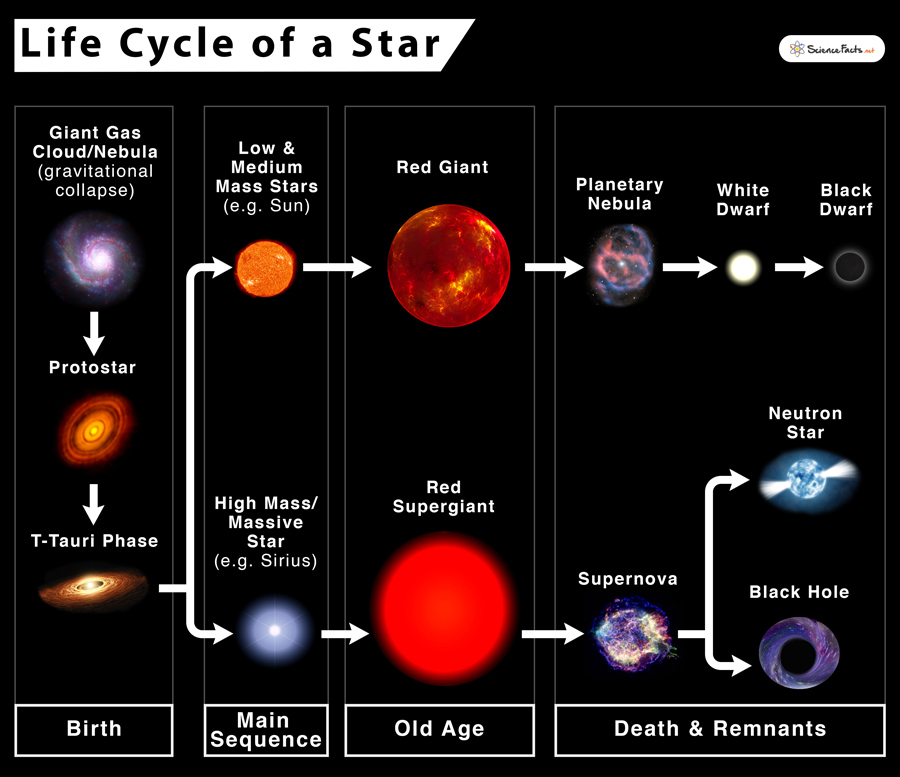
What Determines the Life Cycle of a Star
The mass determines a star’s life cycle. The star’s mass depends upon the amount of stellar material available in the nebula from which it forms. The more massive a star, the shorter is its life span. The reason is that the hydrogen supply of a massive star is used up much quicker due to the higher core temperatures of such stars. Other types of stars tend to burn for longer, though they also tend to be much colder.
Stars Based on Their Mass
1. low mass stars.
Low mass stars have a mass not more than 0.5 solar masses. These stars are the smallest, coldest and dimmest stars in the Universe. They burn red, orange, or in some cases yellow due to their low heat. They burn up their fuel very slowly and have incredibly long lives, anywhere from 10 to 50 billion years. An excellent example of a low mass star is the red dwarf Proxima Centauri, which is closest to the Sun.
2. Medium Mass Stars
Medium mass stars have a mass anywhere from 0.5 to around 3 solar masses. They burn orange and yellow and have an average lifespan of around 5-15 billion years. Our Sun is a medium mass star, and its lifespan is roughly around 11-12 billion years.
3. High Mass Stars
High mass stars have a mass greater than 3 solar masses. They are extremely hot and glow blue and white. They have very short life spans, from a couple of billion years to as low as 10 million years only, and they end their lives with a spectacular explosion. Sirius, the brightest star in the night sky, is a blue high mass star.
Different Stages of a Star’s Life Cycle
The life cycle of a star can be divided into very distinct stages. As stated previously, we can compare it to a human life cycle for easier understanding, as it spans from birth to middle age, and finally, the death of a star.
The first four stages are common to all types of stars.
1. Giant Gas Cloud/Nebula
At the first stage of their lives, stars are formed by the gravitational collapse of giant clouds of dust and gas called Nebulae. This stage is the start of their life cycle.
2. Protostar
A protostar is the result of the gravitational collapse of a nebula. It is the formative phase of a star. During this phase, the infant star strives to gain equilibrium between its internal forces and gravity. A Protostar starts very vastly. It can be billions of kilometers in diameter. It usually lasts for 100,000 years. During this period, the protostar spins very rapidly, generating intense heat and pressure and causing the gas cloud to collapse further.
When the temperature reaches about 10 million K, hydrogen fusion can finally occur, and the star is born.
3. T-Tauri Phase
Before fusion begins, the protostar goes through a period called the T-Tauri phase. At this stage, the core temperatures are still too low for hydrogen fusion, so all the star energy comes from the gravitational force only. The star at this point is about the same size as a low or medium mass star. However, it is much brighter. This period can last up to 100 million years and represents a period of fluctuations in the brightness of a star as it tries to balance its internal and gravitational forces. Once nuclear fusion starts and equilibrium is achieved, the star is considered a Main Sequence star.
4. Main Sequence (Small to Average Stars/Massive Stars)
The Main Sequence signifies the portion of a star’s life where its core is capable of hydrogen fusion. 90% of a star’s life is spent in this stage. The stars in the Main Sequence are of many different masses, colors, and brightness. The amount of time a star spends on the Main Sequence depends directly upon its mass. average stars like the Sun stay on the Main Sequence for billions of years. The smallest stars, the red dwarfs, burn their hydrogen supplies so slowly that none of them have left the Main Sequence since the Universe was formed!
On the other hand, the most massive stars, like Sirius, will use up their hydrogen quickly and exit the Main Sequence after only a few million years. When a star has fused all the hydrogen in its core to helium, it exits the Main Sequence and enters its death throes.
How a star dies depends on its mass.
The following three stages apply only to low and medium(average) mass stars.
5. Red Giant
When a star has fused all the hydrogen in its core, its nuclear radiation output ceases. As a result, the star once again starts collapsing due to gravity. The energy generated by this collapse heats the core enough that the hydrogen in the surrounding stellar atmosphere can be burnt. This process causes the star’s outer layers to expand and cool down to just around 2500-3500 K, thus becoming redder. This stage in a star’s life can last for up to a billion years, and the stars can swell up to 100-1000 times the size of the Sun.
Planetary Nebula : The star’s core continues to heat up, reaching temperatures of up to 100 million K, and helium fusion can now take place in the core. For small and average stars like the Sun, the core will never get hot enough for further fusion. Instead, once the helium in the core is used up, the star expels the outer layers of gas in an explosion, called a planetary nebula, leaving behind a white dwarf.
6. White Dwarf
Once the star’s outer layers are shed, only a tiny core comprising primarily carbon and oxygen remains. The star is called a White Dwarf. Here, the mass of an entire stellar core is condensed into a body roughly the size of the Earth. Such a small size is possible due to the pressure exerted by the fast-moving electrons. This fate is only for those stars whose cores are not bigger than 1.4 solar masses. These stars are scorching; hence, they glow white.
7. Black Dwarf
Black dwarfs are the final stage in the life of a low to medium mass star. They are the remnants of white dwarfs, formed due to the gradual cooling and dimming as they burn their remaining fuel. Eventually, they will exhaust their fuel and keep dimming until they are no longer visible to us. This process takes such a long time that no black dwarfs have formed since the beginning of the Universe, so they are strictly theoretical.
The following three stages apply only to high (massive) mass stars.
5. Red Supergiant
For stars with a mass 8-9 times that of the Sun, the core temperatures become so high that nuclear fusion can occur even after the helium is exhausted. They can swell up to truly spectacular sizes; for example, Betelgeuse, a red supergiant and the tenth brightest star in the sky, is so massive that if it were in the Sun’s place, it would stretch till Jupiter! The process of nuclear fusion in the core carries on till iron is formed. No further fusion can occur at this stage, as fusing iron consumes energy rather than release it.
6. Supernova
The moment the core of a supergiant star turns to iron, it has reached the end of its life. The star collapses instantly under the enormous gravity exerted on its heavy iron core. The core shrinks from around 5000 miles across to just a couple dozen in a matter of seconds, and the temperatures can reach 100 billion K. This collapse triggers an incredible explosion, known as a Supernova. Supernovae are some of the brightest and most violent events in the Universe; they can outshine entire galaxies! The energy released during a supernova is so great that a fusion of iron can finally occur, and all heavier elements are created in the explosion.
7. Neutron Star or Black Hole
After a supernova explosion, all that remains of the star is its core. What happens to this core depends on its mass.
a) Neutron Star: If the collapsing core is of 1.4-3 solar masses, it forms a Neutron Star. A neutron star is a highly dense, heavy, and trim body comprised of neutrally charged neutrons. The force of gravity on the collapsing core is so enormous that the negatively charged electrons are pushed right into the nucleus, where they combine with the positively charged protons to form neutrons. As such, a vast mass is compressed into a body no more than 20 km in diameter. Neutron stars are the densest and heaviest objects in the Universe.
b) Black Hole: For stellar cores of more than 3 solar masses, the force of gravity is so strong that the collapse is unstoppable. Such a big mass collapses to a point known as a singularity. Here, the gravitational force is so strong that nothing can escape it, not even light. Such a phenomenon is called a Black Hole. Their gravity is so strong that black holes even pull in neighboring stars and planets and “eat” them! Since no light or other electromagnetic emissions can escape a black hole, our only way to detect them is to observe them “feeding” on the stellar matter.
Ans: All stars follow a 7-step life cycle from their birth in a nebula to ending up as stellar remnants. It goes from a Protostar to the T-Tauri phase, then the Main Sequence, Red giant or supergiant, fusion of the heavier elements, and finally a Planetary Nebula or a Supernova.
Ans: Brown dwarfs are essentially failed stars. Due to their small size, the core of these stars never achieves a temperature high enough for hydrogen fusion. They can be anywhere from 15 to 80 times the size of Jupiter and are often confused with planets due to their low luminosity.
Ans: Neutron stars do not last forever. Like white dwarfs, they radiate their energy out very slowly and eventually fade until they become undetectable.
Ans. Neutron stars continue to rotate just like the original star. However, since they are much smaller and denser, they rotate at incredible speeds – up to hundreds of times in a second. The rotation, together with their strong magnetic field , causes electromagnetic radiation emitted from the poles. This radiation is detected in pulses; hence, these stars were named “Pulsars”.
- What is a Star – Skyandtelescope.org
- How do stars form and evolve – Science.nasa.gov
- Stellar Evolution – Astronomy.swin.edu.au
- The Life Cycles of Stars: How Supernovae Are Formed – Imagine.gsfc.nasa.gov
- High Mass Stars – Lumenlearning.com
- Types of Stars – Universetoday.com
Article was last reviewed on Thursday, February 2, 2023
Related articles
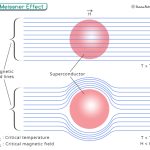
Leave a Reply Cancel reply
Your email address will not be published. Required fields are marked *
Save my name, email, and website in this browser for the next time I comment.
Popular Articles

Join our Newsletter
Fill your E-mail Address
Related Worksheets
- Privacy Policy
© 2024 ( Science Facts ). All rights reserved. Reproduction in whole or in part without permission is prohibited.

The Schools' Observatory
Search form.

- New Password
You are here
Life cycle of a star.
All stars form in nebulae , which are huge clouds of gas and dust. Though they shine for many thousands, and even millions of years, stars do not last forever. The changes that occur in a star over time and the final stage of its life depend on a star's size .
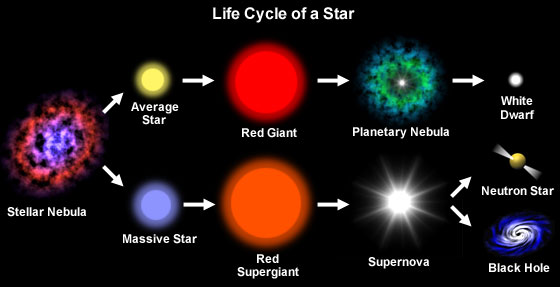
Nuclear reactions at the centre (or core) of a star provides energy which makes it shine brightly. This stage is called the ' main sequence '. The exact lifetime of a star depends very much on its size. Very massive stars use up their fuel quickly. This means they may only last a few hundred thousand years. Smaller stars use up fuel more slowly so will shine for several billion years.
Eventually, the hydrogen which powers the nuclear reactions inside a star begins to run out. The star then enters the final phases of its lifetime. All stars will expand, cool and change colour to become a red giant . What happens next depends on how massive the star is.
A smaller star, like the Sun , will gradually cool down and stop glowing. During these changes it will go through the planetary nebula phase, and white dwarf phase. After many thousands of millions of years it will stop glowing and become a black dwarf.
A massive star experiences a much more energetic and violent end. It explodes as a supernova . This scatters materials from inside the star across space. This material can collect in nebulae and form the next generation of stars. After the dust clears, a very dense neutron star is left behind. These spin rapidly and can give off streams of radiation, known as pulsars .
If the star is especially massive, when it explodes it forms a black hole .
Important Information
Advisory Board Evaluation Terms & Conditions Statistics Strategy 2023-28
schoolsobs@ljmu.ac.uk
Privacy Policy
The Liverpool Telescope is owned and operated by LJMU with financial support from STFC

Star Lifecycle
Observe the formation of stars from the first stages to the formation of planetary systems.
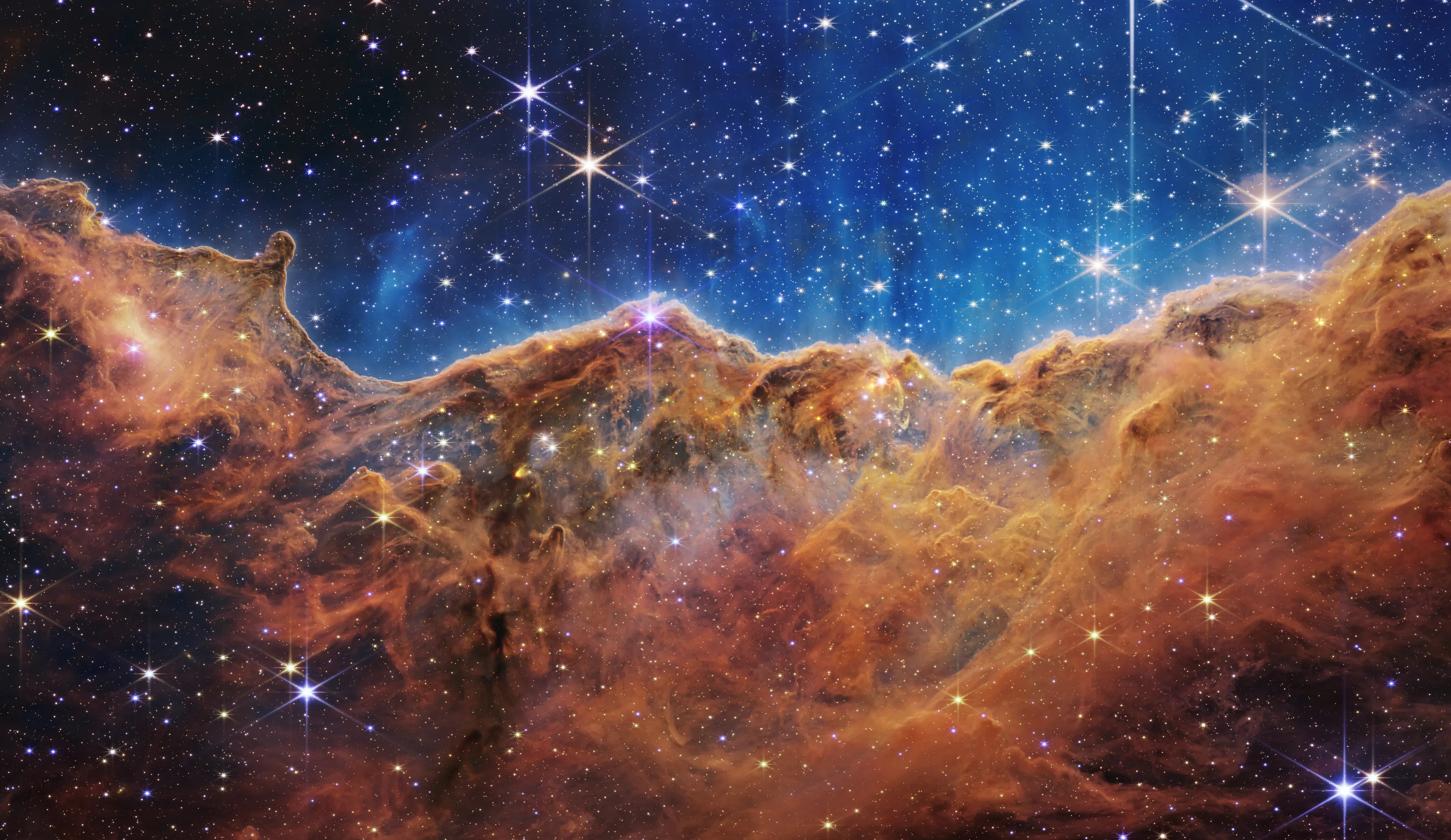
Inside The Pillars Of Creation
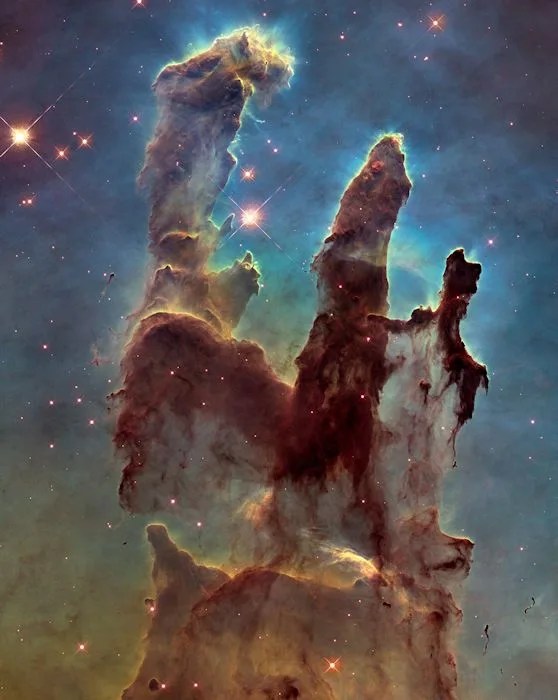
While this image is spectacular, there are actually stars that Hubble can't see inside those pillars of dust. And that's because the visible light emitted by those stars is being obscured by the dust. But what if we used a telescope sensitive to infrared light to look at this nebula?
The next image is another Hubble view, but this time in near-infrared. In the infrared more structure within the dust clouds is revealed and hidden stars have now become apparent. (And if Hubble, which is optimized for visible light, can capture a near-infrared image like this, imagine what Webb, which is optimized for near-infrared and 100x more powerful than Hubble, is doing!)
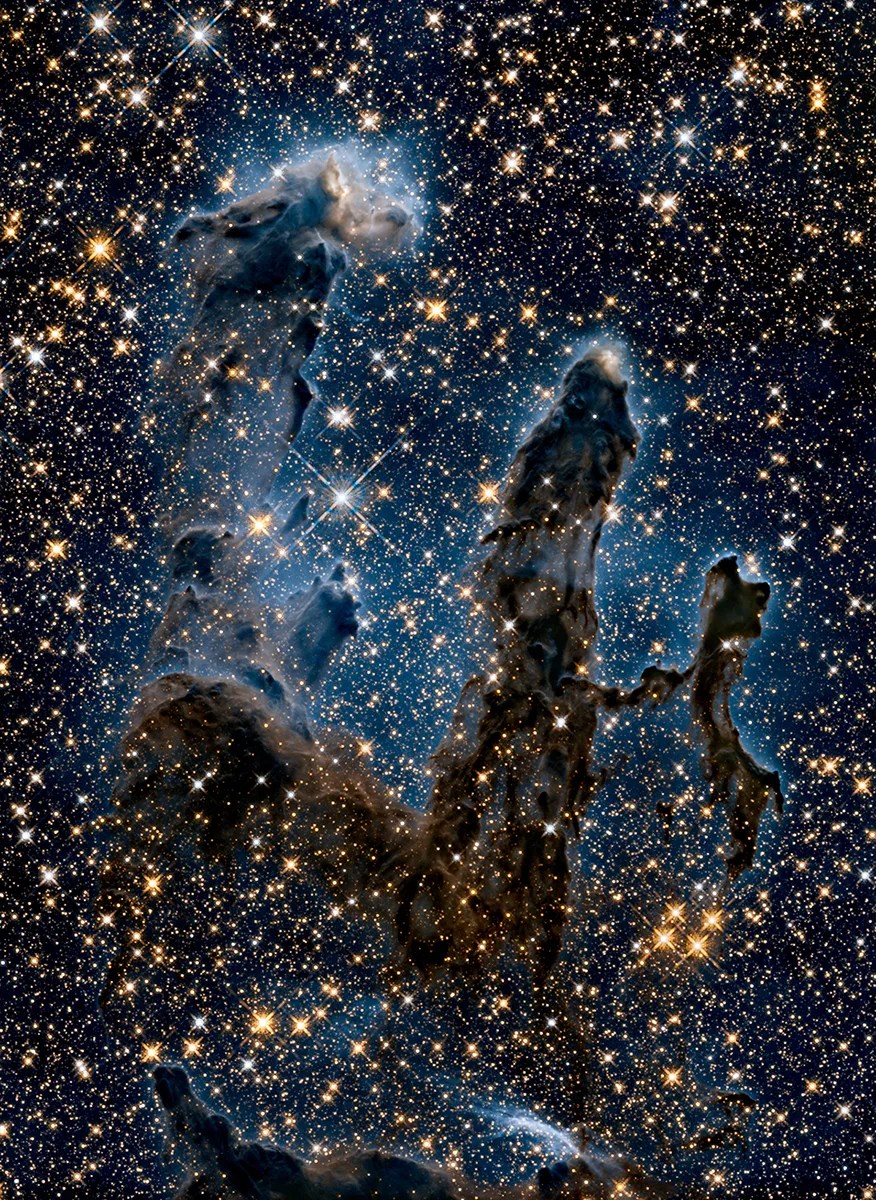
Another nebula, the "Mystic Mountains" of the Carina Nebula, shown in two Hubble images, one in visible light (left) and one in infrared (right).
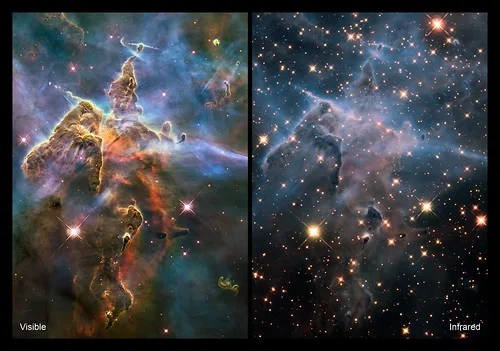
In the infrared image, we can see more stars that just weren't visible before. Why is this?
How Do Infrared Cameras Work?
We can try a thought experiment. What if you were to put your arm into a garbage bag? Your arm is hidden. Invisible. But what if you looked at your arm and the garbage bag with an infrared camera? Remember that infrared light is essentially heat. And that while your eyes may not be able to pick up the warmth of your arm underneath the cooler plastic of the bag, an infrared camera can. An infrared camera can see right through the bag!
And this is how the infrared telescope works as well. It sees the heat or infrared light being emitted by the stars within the cooler dust clouds.
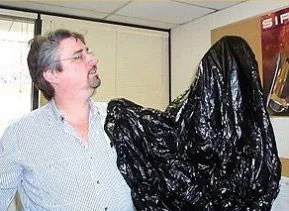
The Dusty Cocoons Of Star And Planet Formation
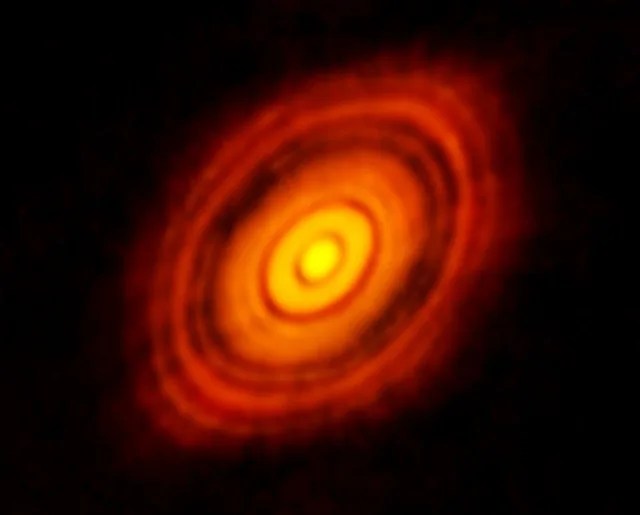
Webb's amazing imaging and spectroscopy capabilities is allowing us to study stars as they are forming in their dusty cocoons. Additionally, it is able to image disks of heated material around these young stars, which can indicate the beginnings of planetary systems, and study organic molecules that are important for life to develop.
Key Questions
Webb is addressing several key questions to help us unravel the story of the star and planet formation:
- How do clouds of gas and dust collapse to form stars?
- Why do most stars form in groups?
- Exactly how do planetary systems form?
- How do stars evolve and release the heavy elements they produce back into space for recycling into new generations of stars and planets?
Webb's Role In Answering These Questions
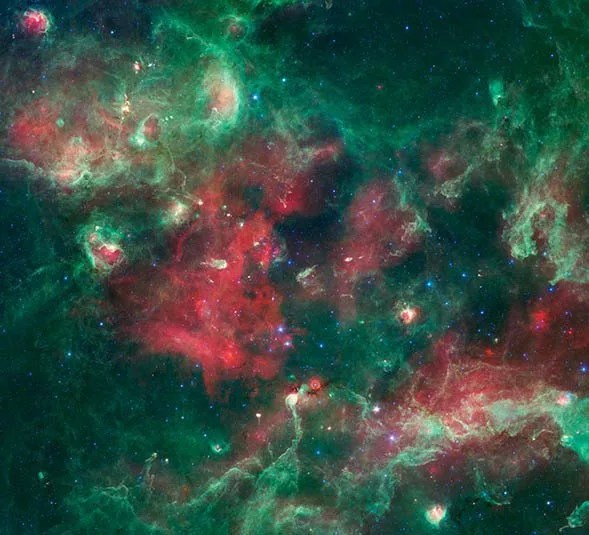
To unravel the birth and early evolution of stars and planets, we need to be able to peer into the hearts of dense and dusty cloud cores where star formation begins. These regions cannot be observed at visible light wavelengths as the dust would make such regions opaque and must be observed at infrared wavelengths.
Stars, like our Sun, can be thought of as "basic particles" of the Universe, just as atoms are "basic particles" of matter. Groups of stars make up galaxies, while planets and ultimately life arise around stars. Although stars have been the main topic of astronomy for thousands of years, we have begun to understand them in detail only in recent times through the advent of powerful telescopes and computers.
A hundred years ago, scientists did not know that stars are powered by nuclear fusion, and 50 years ago they did not know that stars are continually forming in the Universe. Researchers still do not know the details of how clouds of gas and dust collapse to form stars, or why most stars form in groups, or exactly how planetary systems form. Young stars within a star-forming region interact with each other in complex ways. The details of how they evolve and release the heavy elements they produce back into space for recycling into new generations of stars and planets remains to be determined through a combination of observation and theory.
The stages of solar system formation are illustrated to the right: starting with a protostar embedded in a gas cloud (upper left of diagram), to an early star with a circumstellar disk (upper right), to a star surrounded by small "planetesimals" which are starting to clump together (lower left) to a solar system like ours today.
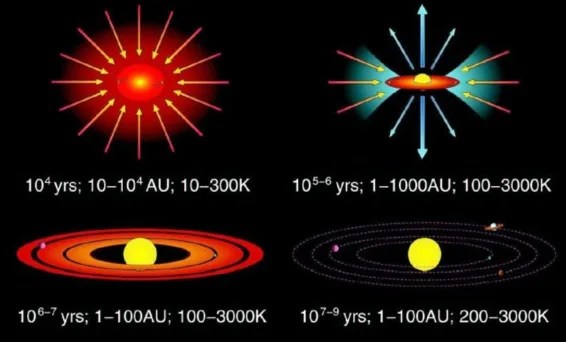
The continual discovery of new and unusual planetary systems has made scientists re-think their ideas and theories about how planets are formed. Scientists realize that to get a better understanding of how planets form, they need to have more observations of planets around young stars, and more observations of leftover debris around stars, which can come together and form planets.
If you're seeing this message, it means we're having trouble loading external resources on our website.
If you're behind a web filter, please make sure that the domains *.kastatic.org and *.kasandbox.org are unblocked.
To log in and use all the features of Khan Academy, please enable JavaScript in your browser.
American Museum of Natural History
Course: american museum of natural history > unit 2.
- What is a Star?
Lives of Stars
- Our Star: the Sun
- Space Weather: Storms From the Sun
- Interferometry: Sizing Up the Stars
- Neil deGrasse Tyson on Finding Krypton
- Stars Glossary
- Quiz: Stars
- Exploration Questions: Stars
- Answers to Exploration Questions: Stars
Low-mass stars (8 to 80 percent of the Sun’s mass)
Intermediate-mass stars (0.8 to 8 times the sun’s mass).
High-mass stars (8 to 20 times the Sun’s mass)
Very high-mass stars (20 to 100 times the Sun’s mass)
Want to join the conversation?
- Upvote Button navigates to signup page
- Downvote Button navigates to signup page
- Flag Button navigates to signup page


Everything you wanted to know about stars
These luminous balls of gas helped ancient explorers navigate the seas and now help modern-day scientists navigate the universe.
Gently singing Twinkle, twinkle, little star may lull a baby to sleep, but beyond the confines of Earth’s atmosphere, the words aren’t exactly accurate. A correct, albeit less soothing, rendition might be: Emit, emit, gigantic ball of gas .
Stars are huge celestial bodies made mostly of hydrogen and helium that produce light and heat from the churning nuclear forges inside their cores. Aside from our sun, the dots of light we see in the sky are all light-years from Earth. They are the building blocks of galaxies, of which there are billions in the universe. It’s impossible to know how many stars exist, but astronomers estimate that in our Milky Way galaxy alone, there are about 300 billion .
A star is born
The life cycle of a star spans billions of years. As a general rule, the more massive the star, the shorter its life span.
Birth takes place inside hydrogen-based dust clouds called nebulae . Over the course of thousands of years, gravity causes pockets of dense matter inside the nebula to collapse under their own weight. One of these contracting masses of gas, known as a protostar, represents a star’s nascent phase. Because the dust in the nebulae obscures them, protostars can be difficult for astronomers to detect.
As a protostar gets smaller, it spins faster because of the conservation of angular momentum—the same principle that causes a spinning ice skater to accelerate when she pulls in her arms. Increasing pressure creates rising temperatures, and during this time, a star enters what is known as the relatively brief T Tauri phase.
Millions of years later, when the core temperature climbs to about 27 million degrees Fahrenheit (15 million degrees Celsius), nuclear fusion begins, igniting the core and setting off the next—and longest—stage of a star’s life, known as its main sequence.
For Hungry Minds
Most of the stars in our galaxy, including the sun, are categorized as main sequence stars. They exist in a stable state of nuclear fusion, converting hydrogen to helium and radiating x-rays. This process emits an enormous amount of energy, keeping the star hot and shining brightly.
All that glitters
Some stars shine more brightly than others. Their brightness is a factor of how much energy they put out–known as luminosity –and how far away from Earth they are. Color can also vary from star to star because their temperatures are not all the same. Hot stars appear white or blue, whereas cooler stars appear to have orange or red hues.
By plotting these and other variables on a graph called the Hertzsprung-Russell diagram, astronomers can classify stars into groups. Along with main sequence and white dwarf stars, other groups include dwarfs, giants, and supergiants. Supergiants may have radii a thousand times larger than that of our own sun.
You May Also Like
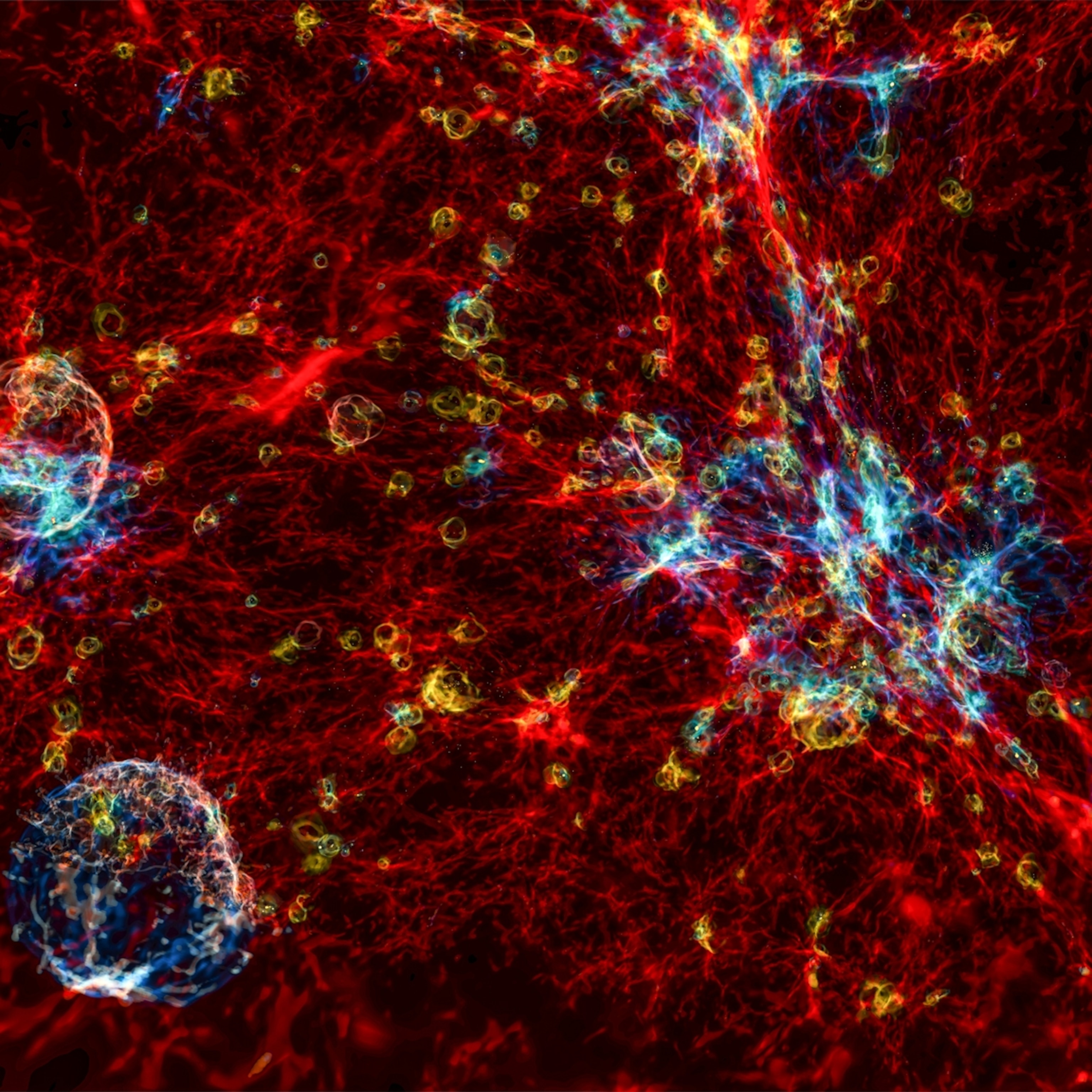
The world’s most powerful telescope is rewriting the story of space and time

This is what the first stars looked like as they were being born

Most distant star ever seen found in Hubble Space Telescope image
Stars spend 90 percent of their lives in their main sequence phase. Now around 4.6 billion years old, Earth’s sun is considered an average-size yellow dwarf star, and astronomers predict it will remain in its main sequence stage for several billion more years.
As stars move toward the ends of their lives, much of their hydrogen has been converted to helium. Helium sinks to the star's core and raises the star's temperature—causing its outer shell of hot gases to expand. These large, swelling stars are known as red giants. But there are different ways a star’s life can end, and its fate depends on how massive the star is.
The red giant phase is actually a prelude to a star shedding its outer layers and becoming a small, dense body called a white dwarf . White dwarfs cool for billions of years. Some, if they exist as part of a binary star system , may gather excess matter from their companion stars until their surfaces explode, triggering a bright nova. Eventually all white dwarfs go dark and cease producing energy. At this point, which scientists have yet to observe, they become known as black dwarfs.
Massive stars eschew this evolutionary path and instead go out with a bang—detonating as supernovae . While they may appear to be swelling red giants on the outside, their cores are actually contracting, eventually becoming so dense that they collapse, causing the star to explode. These catastrophic bursts leave behind a small core that may become a neutron star or even, if the remnant is massive enough, a black hole .
Because certain supernovae have a predictable pattern of destruction and resulting luminosity, astronomers are able to use them as “standard candles,” or astronomical measuring tools, to help them measure distances in the universe and calculate its rate of expansion.
See stunning photos of nebulae

Depending on cloud cover and where you’re standing, you may see countless stars blanketing the sky above you, or none at all. In cities and other densely populated areas, light pollution makes it nearly impossible to stargaze. By contrast, some parts of the world are so dark that looking up reveals the night sky in all its rich celestial glory.
Ancient cultures looked to the sky for all sorts of reasons. By identifying different configurations of stars—known as constellations—and tracking their movements, they could follow the seasons for farming as well as chart courses across the seas. There are dozens of constellations . Many are named for mythical figures, such as Cassiopeia and Orion the Hunter. Others are named for the animals they resemble, such as Ursa Minor (Little Bear) and Canus Major (Big Dog).
Today astronomers use constellations as guideposts for naming newly discovered stars. Constellations also continue to serve as navigational tools. In the Southern Hemisphere, for example, the famous Southern Cross constellation is used as a point of orientation. Meanwhile people in the north may rely on Polaris, or the North Star, for direction. Polaris is part of the well-known constellation Ursa Minor, which includes the famous star pattern known as the Little Dipper.
Related Topics
- SCIENCE AND TECHNOLOGY

What’s out there? Why humanity keeps pushing the cosmic frontier.

This Doctor Upended Everything We Knew About the Human Heart

What is causing these massive, mysterious explosions in space?
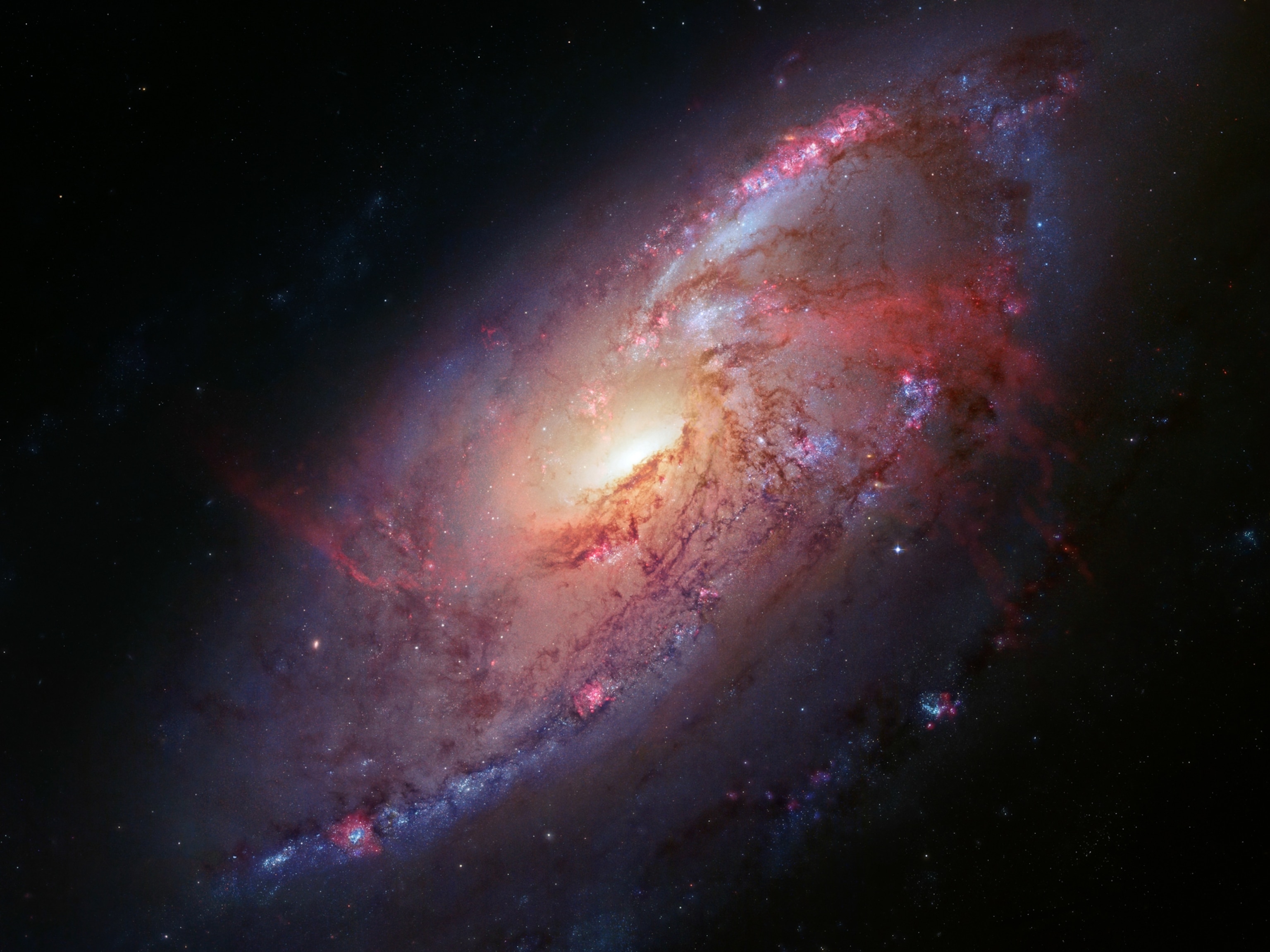
How fast is the universe really expanding? The mystery deepens.
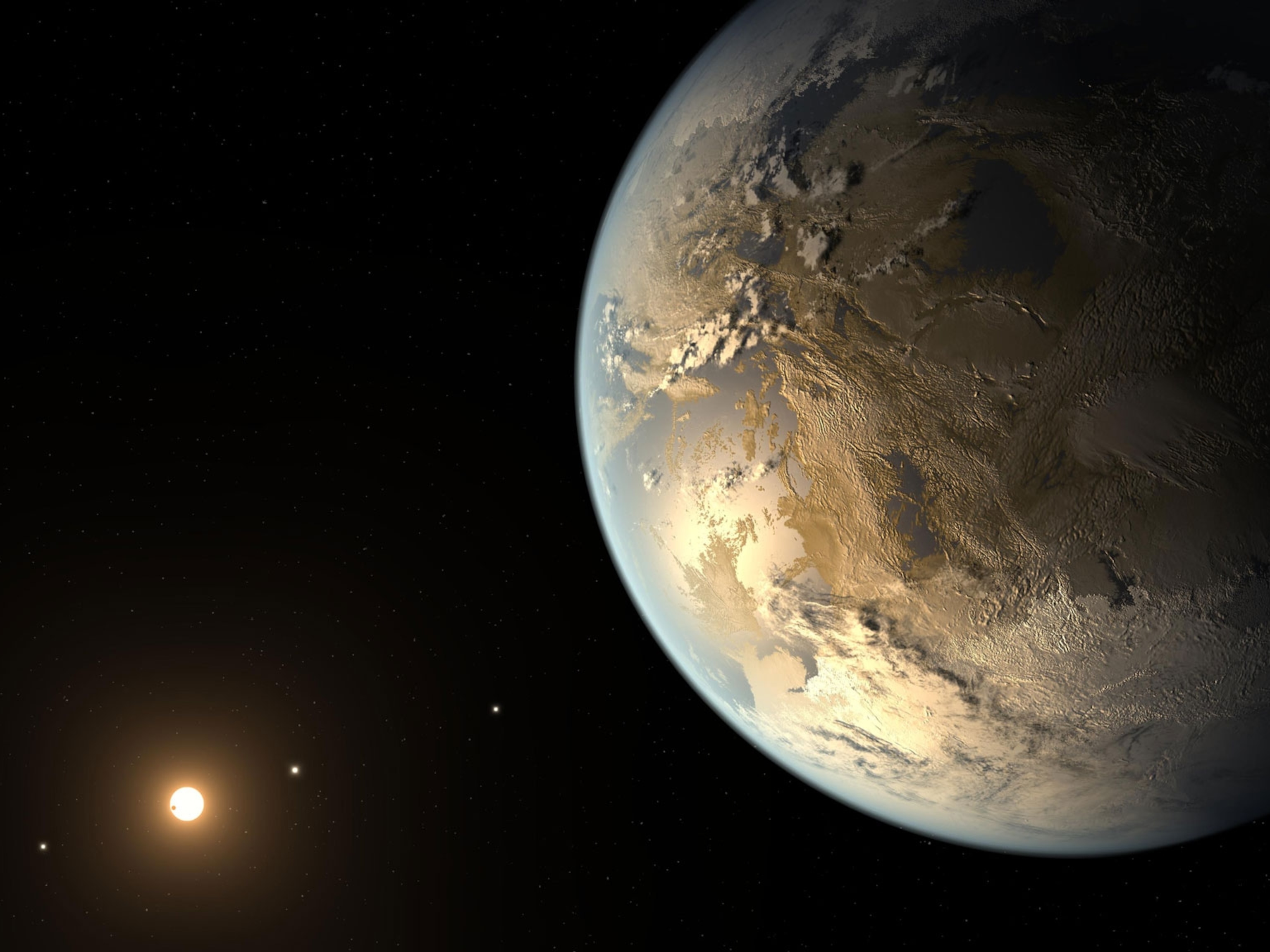
Astronomers identify the stars where any aliens would have a view of Earth
- Environment
- Perpetual Planet
History & Culture
- History & Culture
- History Magazine
- Mind, Body, Wonder
- Paid Content
- Terms of Use
- Privacy Policy
- Your US State Privacy Rights
- Children's Online Privacy Policy
- Interest-Based Ads
- About Nielsen Measurement
- Do Not Sell or Share My Personal Information
- Nat Geo Home
- Attend a Live Event
- Book a Trip
- Inspire Your Kids
- Shop Nat Geo
- Visit the D.C. Museum
- Learn About Our Impact
- Support Our Mission
- Advertise With Us
- Customer Service
- Renew Subscription
- Manage Your Subscription
- Work at Nat Geo
- Sign Up for Our Newsletters
- Contribute to Protect the Planet
Copyright © 1996-2015 National Geographic Society Copyright © 2015-2024 National Geographic Partners, LLC. All rights reserved
- Ask An Astrobiologist
- Resources Graphic Histories Coloring Pages Heroes Posters Life in the extremes Digital Backgrounds SciComm Guild

1. How did matter come together to make planets and life in the first place?
1.1. are we really made of star stuff.

Grades K-2 or Adult Naive Learner
- NGSS Connections for Teachers
- Concept Boundaries for Scientists
Have you ever wondered what we’re made of? Would you believe that you and me and all of the plants and all of the animals that we can see are all made of the same kind of stuff that makes up books and rocks and mountains and the ocean? We’re all made from the same kind of stuff, and we call that stuff “matter”.
Can you guess where all of that matter came from? It was all made in space! A lot of that stuff, that matter, that makes up you and me and the place we live was made inside of stars long, long ago. So long ago that it’s older than your parents, it’s older than the dinosaurs, and it’s even older than the Sun!
We’re all made of the stuff from stars!
Disciplinary Core Ideas
PS1.A: Structure and Properties of Matter: - Different kinds of matter exist and many of them can be either solid or liquid, depending on temperature. Matter can be described and classified by its observable properties. (2-PS1-1) - Different properties are suited to different purposes. (2-PS1-2, 2-PS1-3) - A great variety of objects can be built up from a small set of pieces. (2-PS1-3)
ESS1.A: The Universe and Its Stars: Patterns of the motion of the Sun, moon, and stars in the sky can be observed, described, and predicted. (1-ESS1-1)
ESS1.B: Earth and the Solar System: Seasonal patterns of Sunrise and Sunset can be observed, described, and predicted. (1-ESS1-2)
ESS1.C: The History of Planet Earth: Some events happen very quickly; others occur very slowly, over a time period much longer than one can observe. (2-ESS1-1)
Crosscutting Concepts
Patterns in the natural world can be observed, used to describe phenomena, and used as evidence. (K-LS1-1)
Big Ideas: The solar system consists of Earth and seven other planets spinning around the Sun. The Sun and planets formed from a huge cloud of gas and dust. Everything is made of matter. Much of the matter that makes up people and planets was made inside of stars long ago.
Boundaries: By the end of 2nd grade, students can understand/describe the patterns of the Sun, the Moon, and the stars as viewed from Earth, and make observations/predictions about them. Students will also understand seasonal patterns of Sunrise and Sunset. Grade level appropriate observations include: the Sun and moon appear to rise and set in different parts of the sky, and star visibility at night, but not in the day (except for our Sun). These observations can be used as evidence in supporting their understanding of Earth’s place in the universe.
No appropriate content for this grade level. Please use the navigation arrows to switch levels.
Grades 3-5 or Adult Emerging Learner
The story of where we came from begins in space, a long time ago, even before the Sun and the planets in our solar system formed. A lot of the stuff, the matter, that makes up you and me and everything we see on Earth was formed inside of stars long ago.
Sometimes when we talk about stars, we talk about them as if they’re living things. So, we’ll say that a star is born, it has a life, and then it dies, and we call this a “lifecycle.” A star can be born and start its lifecycle when a bunch of dust and ice in space comes together. Just like when you drop something and it falls because of gravity, when there’s a lot of ice and dust together in space, it can fall together because of gravity and make up an entire star. Once a star is born, it starts to make light and heat, just like our Sun, and, when that happens, it starts creating different kinds of matter inside. Even right now, our own Sun is making new kinds of matter inside of it from the other stuff that’s there.
So, how does all of that new matter that’s created inside of stars get out and end up inside of you and me and other stuff? Well, some stars, when they get old and are at the end of their life cycles, will explode and send all of that new matter out into space. Then, later on, when new stars and new planets are forming, some of that new matter ends up in them. So, a lot of the matter that’s inside of our Sun and inside of our planet and even inside of us was made within stars long, long ago. That means that you are made of star stuff!
ESS1.A: The Universe and its Stars: The Sun is a star that appears larger and brighter than other stars because it is closer. Stars range greatly in their distance from Earth. (5-ESS1-1)
PS3.A: Definitions of Energy: The faster a given object is moving, the more energy it possesses. (4-PS3-1) Energy can be moved from place to place by moving objects or through sound, light, or electric currents. (4-PS3-2, 4-PS3-3)
PS3.B: Conservation of Energy and Energy Transfer: Energy is present whenever there are moving objects, sound, light, or heat. When objects collide, energy can be transferred from one object to another, thereby changing their motion. In such collisions, some energy is typically also transferred to the surrounding air; as a result, the air gets heated and sound is produced. (4-PS3-2, 4-PS3-3) *Light also transfers energy from place to place. (4-PS3-2)
Patterns can be used as evidence to support an explanation. (4-ESS1-1, 4-ESS2-2)
Big Ideas: The planets of the solar system and the Sun all formed from a large cloud of gas and dust a long time ago. While there are many stars in the universe, the Sun is the closest one to Earth so it appears to be the largest. Stars vary in size and proximity to Earth. All stars have a life cycle and some produced the matter that makes up life here on Earth. Some of the patterns in the universe can be observed here on Earth. The gravitational force of Earth acting on an object near Earth’s surface pulls the object towards the planets center.
Boundaries: By the end of 5th grade, students will understand the Sun appears larger and brighter than other stars because of its proximity to Earth. References to time (i.e. “a long time ago”) emphasize relative time rather than a specific time. In this grade band, no attempt is made to give a precise or complete definition of energy.
3-5 SpaceMath Problem 541: How to Build a Planet. Students study planet growth by using a clay model of planetesimals combining to form a planet by investigating volume addition with spheres. [Topics: graphing; counting] https://spacemath.gsfc.nasa.gov/astrob/10Page4.pdf
5-12 What are we made of? The Sun, the Earth and You. In this hands-on activity, students use a model of the particles in the solar wind as determined by the Genesis mission to compare the elements of the Sun and the Earth. This student-centered lesson supports the cosmic connection to life on Earth. http://genesismission.jpl.nasa.gov/educate/bead_activity/tg_bead_activ.pdf
Grades 6-8 or Adult Building Learner
The story of where we came from begins in space. All of the matter that makes up you and me and everything we see on Earth is composed of the chemical elements. If you think about all of the elements on the periodic table, things like oxygen and carbon and iron, almost all of those elements that we see and that make up the stuff around us formed inside of stars long ago.
When the universe was young, before there were any galaxies or stars or planets, the only elements that existed were hydrogen and helium and a little bit of lithium. These are the first and lightest elements on the periodic table. As time passed in the universe, some of the earliest matter, the hydrogen and helium and lithium, started to clump together. When this happened, it made the first stars.
Something really cool can happen inside of stars, where nuclear fusion causes some of the lighter elements to come together, or fuse, and make heavier elements. So, things like hydrogen and helium were fused together to make heavier elements, like carbon, and then those heavier elements could make even heavier elements. Stars are like big chemical element factories! Even our Sun is currently making new elements inside of it.
All stars will eventually burn out, but, for some of the stars, when they burn out, or reach the end of their “life cycles” they can explode and blow out all of the heavy elements that were inside. These explosions can also make new, even heavier elements. Then, later on, when new stars and new planets are forming from the matter in space clumping together, some of these heavier elements end up in them. So, a lot of the matter that’s inside of our Sun and inside of our planet and even inside of us was made within stars long, long ago. That means that you are made of star stuff!
PS1.A: Structure and Properties of Matter: - Substances are made from different types of atoms, which combine with one another in various ways. Atoms form molecules that range in size from two to thousands of atoms. (MS-PS1-1) - Each pure substance has characteristic physical and chemical properties (for any bulk quantity under given conditions) that can be used to identify it. (MS-PS1-3) - In a solid, atoms are closely spaced and may vibrate in position but do not change relative locations. (MS-PS1-4) - Solids may be formed from molecules, or they may be extended structures with repeating subunits (e.g., crystals). (MS-PS1-1) - The changes of state that occur with variations in temperature or pressure can be described and predicted using these models of matter. (MS-PS1-4)
PS1.C (only in Framework): Nuclear fusion can result in the merging of two nuclei to form a larger one, along with the release of significantly more energy per atom than any chemical process. It occurs only under conditions of extremely high temperature and pressure. Nuclear fusion taking place in the cores of stars provides the energy released (as light) from those stars and produced all of the more massive atoms from primordial hydrogen. Thus the elements found on Earth and throughout the universe (other than hydrogen and most of helium, which are primordial) were formed in the stars or supernovas by fusion processes.
Time, space and energy phenomena can be observed at various scales using models to study systems that are too large or too small. (MS-PS1-1)
Big Ideas: The universe began with a period of extreme and rapid expansion known as the big bang. The Milky Way galaxy is one of many galaxies in the universe. Earth and its solar system are a part of the Milky Way. All of the elements that make up Earth have been formed over billions of years through the life cycle of stars. The process of producing elements inside of stars is called fusion. Through fusion, lighter elements combine to form heavier elements, releasing energy in the process. All of the elements in the universe were made this way and this process continues today.
Boundaries: By the end of 8th grade, students use models to observe, describe, predict and explain the motion of the Sun, the Moon, and the stars. Models can be physical, graphical, or conceptual. Forces that act at a distance (gravitational, electric, and magnetic) can be explained by force fields that extend through space and can be mapped by their effect on a test object (a ball, a charged object, or a magnet, respectively). Additionally, students at this level can understand atoms and the properties of elements.
4-6 SpaceMath Problem 294: Star Cluster Math. A simple counting exercise involving star classes lets students work with percentages and ratios. [Topics: counting; percentage; scaling] https://spacemath.gsfc.nasa.gov/stars/5Page53new.pdf
6-8 SpaceMath Problem 480: The Expanding Gas Shell of U Camelopardalis. Students explore the expanding U Camelopardalis gas shell imaged by the Hubble Space Telescope, to determine its age and the density of its gas. [Topics: scientific notation; distance = speed x time; density=mass/volume] https://spacemath.gsfc.nasa.gov/stars/9Page2.pdf
6-8 SpaceMath Problem 182: Our Neighborhood in the Milky Way. Students create a scale model of the local Milky Way and estimate distances and travel times for a series of voyages. [Topics: scale models; speed-distance-time] https://spacemath.gsfc.nasa.gov/stars/5Page30.pdf
6-8 SpaceMath Problem 544: The Composition of Planetary Atmospheres. Students study the composition of planetary atmospheres and compare the amounts of certain compounds in them [Topics: pie graphs; percentages; scientific notation] https://spacemath.gsfc.nasa.gov/Grade67/10Page7.pdf
6-8 Explore! Jupiter’s Family Secrets. In this one-hour lesson for formal or informal education, students connect their own life story to a cultural creation story and then the “life” story of Jupiter. This “life” story of Jupiter includes the Big Bang as the beginning of the universe, the creation of elements through stars and the creation of the solar system. JPL /NASA http://www.lpi.usra.edu/education/explore/solar_system/activities/birthday/
6-9 Rising Stargirls Teaching and Activity Handbook. Constellations (page 13). Introduces students to what constellations are, to their subjective nature, and to the range of cultures that have named constellations. In Make Your Own Constellation (page 15) students are given an introduction to some constellations in the night sky and create their own constellations. Rising Stargirls activities are a part of a 10-day workshop dedicated to encouraging girls of all backgrounds to learn, explore, and discover the universe through interactive astronomy using theater, writing, and visual art. This provides an avenue for individual self-expression and personal exploration that is interwoven with scientific engagement and discovery. together, both science and the arts can create enlightened future scientists and imaginative thinkers. Rising Stargirls. https://static1.squarespace.com/static/54d01d6be4b07f8719d7f29e/t/5748c58ec2ea517f705c7cc6/1464386959806/Rising_Stargirls_Teaching_Handbook.compressed.pdf
6-12 Formation of Galaxies. This engaging three-day lesson uses the 5E approach to have students explore gravity and the formation of galaxies through a variety of methods, including a gravity simulator. This lesson develops students’ understanding of the early universe and how galaxy formation is driven by initial conditions, gravity, and time. This sample lesson is part of the Voyages through Time Curriculum: Cosmic Evolution. SETI . http://www.voyagesthroughtime.org/cosmic/sample/lesson5/z_act1.htm
6-12 Astrobiology Math. This collection of math problems provides an authentic glimpse of modern astrobiology science and engineering issues, often involving actual research data. Students explore concepts in astrobiology through calculations. Relevant topics that support the origin of the universe include Counting Galaxies with the Hubble Space Telescope (page 103) and Our Neighborhood in the Milky Way (page 113). NASA . https://www.nasa.gov/pdf/637832main_Astrobiology_Math.pdf
6-12 Dawn: Find a Meteorite. This online activity (45-90 minutes) introduces the importance of meteorites to the understanding of the origin of the Solar System. Learners use a key to determine if samples are meteorites. Finding meteorites can be difficult because most meteorites look like Earth rocks to the casual or untrained eye. These lessons require multiple computers for individuals, pairs, or small groups. JPL /NASA. https://dawn.jpl.nasa.gov/Meteorite/
7-12 Cosmic Times. In this blast from the past, students go through an online newspaper that chronicles the events surrounding the Big Bang. The articles and pictures provide a glimpse of the evidence and possible hypotheses involved in the Big Bang Theory in order to evaluate possible solutions. NASA http://cosmictimes.gsfc.nasa.gov/
7-12 Cosmic Questions. This collection of eight 30-45 minute lessons was developed to support the information in the informal education exhibit Cosmic Questions. The lessons include subjects such as the Big Bang Theory and its evidence. Each lesson is stand-alone. The activity “Comparing Optical and X-Ray images” (page 31) provides students with the opportunity to compare shreds of an exploded star and a star ejecting matter as it expands. In the activity “Modeling the Expanding Universe,” students visualize the universe expanding in all directions during the Big Bang (page 39). Harvard-Smithsonian/NSF/NASA. https://www.cfa.harvard.edu/seuforum/exhibit/resources/CQEdGuide.pdf#page=18
8-10 SpaceMath Problem 416: Kepler probes the interior of red giant stars. Students use the properties of circular arcs to explore sound waves inside stars. [Topics: geometry of circles and arcs; distance=speed x time] https://spacemath.gsfc.nasa.gov/stars/7Page80.pdf
8-10 SpaceMath Problem 121: Ice on Mercury? Since the 1990’s, radio astronomers have mapped Mercury. An outstanding curiosity is that in the polar regions, some craters appear to have ‘anomalous reflectivity’ in the shadowed areas of these craters. One interpretation is that this is caused by subsurface ice. The MESSENGER spacecraft hopes to explore this issue in the next few years. In this activity, students measure the surface areas of these potential ice deposits and calculate the volume of water that they imply. [Topics: area of a circle; volume, density, unit conversion] https://spacemath.gsfc.nasa.gov/Geometry/4Page23.pdf
8-10 SpaceMath Problem 124: The Moon’s Atmosphere! Students learn about the moon’s very thin atmosphere by calculating its total mass in kilograms using the volume of a spherical shell and the measured density. [Topics: volume of sphere, shell; density-mass-volume; unit conversions] https://spacemath.gsfc.nasa.gov/moon/4Page26.pdf
Grades 9-12 or Adult Sophisticated Learner
Our planet and all of the living things on it are made from matter. Most of that matter was created during the big bang and the rest was mostly created within the cores of ancient stars. During the big bang, all of the hydrogen, most of the helium, and some of the lithium in our universe was created from subatomic particles, like protons and neutrons. Protons and neutrons are sometimes called “nucleons”, since they are in the nuclei of atoms. Since protons and neutrons came together to make the nuclei of these lighter elements during the big bang, we call this process “big bang nucleosynthesis.”
It was this earliest matter, composed of the three lightest elements on the periodic table, that made the very first stars. And these stars were big and bright and they burned out really fast. We call them the “first generation stars”. It was within the cores of these first stars that the process of nuclear fusion first started creating elements heavier than lithium. The hydrogen and the helium inside were squeezed so tightly and with so much energy, that they started forming things like carbon and nitrogen and oxygen. Much like big bang nucleosynthesis, where new elements had been formed, we call this process of forming new elements from nuclear fusion within stars “stellar nucleosynthesis.”
When those first stars “burned up” their elemental “fuel,” they went through a process called “supernova”, where the stars explode and send a lot of their matter out into space. Then, new stars were able to form from the matter that had clumped up in space, including these heavier elements that were made from stellar nucleosynthesis. In this way, each new generation of stars will have more and more of the heavier elements inside of them.
Something really interesting is that the process of stellar nucleosynthesis can make all of the atoms on the periodic table up to iron (element number 26), but it actually takes too much energy to make the elements that are heavier than iron inside of stars. Can you guess where the energy might come from, then, to make all of those other elements we see in nature that are heavier than iron? When a star goes supernova and explodes, there’s actually enough energy to make those heavier elements! We call this process of nucleosynthesis “supernova nucleosynthesis”. Together, all of the various nucleosynthesis reactions explain how all of the matter that makes up our world and living things came to be. That’s why you’ll often hear people exclaim that we are made of star stuff!
ESS1.A: The Universe and its stars: - The star called the Sun is changing and will burn out over a lifespan of approximately 10 billion years. (HS-ESS1-1) *The study of stars’ light spectra and brightness is used to identify compositional elements of stars, their movements, and their distances from Earth. (HS-ESS1-2, HS-ESS1-3) - The big-bang theory is supported by observations of distant galaxies receding from our own, of the measured composition of stars and non-stellar gases, and of the maps of spectra of the primordial radiation (cosmic microwave background) that still fills the universe. (HS-ESS1-2) - Other than the hydrogen and helium formed at the time of the big bang, nuclear fusion within stars produces all atomic nuclei lighter than and including iron, and the process releases electromagnetic energy. Heavier elements are produced when certain massive stars achieve a supernova stage and explode. (HS-ESS1-2, HS-ESS1-3)
ESS1.B: Earth and the Solar System: Kepler’s laws describe common features of the motions of orbiting objects, including their elliptical paths around the Sun. Orbits may change due to the gravitational effects from, or collisions with, other objects in the solar system. (HS-ESS1-4)
PS1.C: Nuclear Processes: Nuclear processes, including fusion, fission, and radioactive decays of unstable nuclei, involve release or absorption of energy. The total number of neutrons plus protons does not change in any nuclear process. (HS-PS1-8)
PS3.D: Energy in Chemical Processes and Everyday Life: Nuclear Fusion processes in the center of the Sun release the energy that ultimately reaches Earth as radiation.
The significance of a phenomenon is dependent on the scale, proportion, and quantity at which it occurs. (HS-ESS1-1)
Big Ideas: The solar system formed from a large cloud of gas and dust drawn together by gravitational forces. Nearly all of the observable matter in the universe is made up of hydrogen and helium formed during the big bang. Stars go through a sequence of developmental stages — they are formed; evolve in size, mass, and brightness; and eventually burn out. Material from earlier stars that exploded as supernovas is recycled to form younger stars and their planetary systems. Most of the other elements have been born from the life cycle, or evolution, of stars where lighter elements such as hydrogen and helium combine into heavier elements like oxygen and carbon through fusion. The heaviest elements are formed when stars go supernova, creating enough energy to fuse molecules together into carbon, oxygen, and even gold. The solar system and much of the matter in it, has been formed inside of stars that have gone through their life cycle.
Boundaries: By the end of 12th grade, Newton’s law of universal gravitation and Coulomb’s law provide the mathematical models to describe and predict the effects of gravitational and electrostatic forces between distant objects. Students learn to distinguish between different types of energy (ie chemical, mechanical, electrical). Emphasis is on the way nucleosynthesis, and therefore the different elements created, varies as a function of the mass of a star and the stage of its lifetime. Does not include details of the atomic and subatomic processes involved with the Sun’s nuclear fusion. Additionally, students at this level can understand atoms and how their position on the periodic table predicts the properties of elements. (HS-ESS1-1)
9-11 SpaceMath Problem 181: Extracting Oxygen from Moon Rocks. Students use a chemical equation to estimate how much oxygen can be liberated from a sample of lunar soil. [Topics: ratios; scientific notation; unit conversions] https://spacemath.gsfc.nasa.gov/moon/5Page28.pdf
9-12 SpaceMath Problem 483: The Radioactive Dating of a Star in the Milky Way! Students explore Cayrel’s Star, whose age has been dated to 12 billion years using a radioisotope dating technique involving the decay of uranium-238. [Topics: half-life; exponential functions; scientific notation] https://spacemath.gsfc.nasa.gov/stars/9Page5.pdf
9-12 SpaceMath Problem 482: Exploring Density, Mass and Volume Across the Universe. Density is an important feature of matter. Students calculate the density of various astronomical objects and convert them into hydrogen atoms per cubic meter in order to compare how astronomical objects differ enormously in their densities. [Topics: density=mass/volume; scientific notation; unit conversion; metric math] https://spacemath.gsfc.nasa.gov/stars/9Page4.pdf
9-12 Kinesthetic Big Bang. In this one-hour activity students model the time after the Big Bang when the first nuclei of hydrogen and helium were created. The students move and display cards that show the elements that are formed. The creation of these initial elements is the foundation for later star and planet evolution. NASA . https://www.nasa.gov/pdf/190387main_Cosmic_Elements.pdf#page=22
9-12 Cosmology and Big Bang Primer. This website presents foundational information and concepts about Cosmology and our current understanding of the Universe. This is more useful for educators than most students. The information includes the Big Bang theory and evidence for it. NASA . http://wmap.gsfc.nasa.gov/universe/
9-12 Dying Stars and the Birth of Elements. In this student software-based interactive lesson, students use a simulator of an orbiting X-ray observatory to observe a supernova remnant, the expanding gas from an exploded star. They take X-ray spectral data, analyze them, and answer questions based on that data. Supernovas create elements that make up planets and life, so this lesson supports the study of the origins of the universe. XMM -Newton Education and Outreach Sonoma State University. http://xmm.sonoma.edu/edu/clea/XRaySNR_Manual.pdf
Storyline Extensions
Organic molecules are made in space:.
Simple organic molecules, some of which are the building blocks in the biochemical pathways of life, can be produced in space! Astrochemists can use telescopes to observe a large variety of organic molecules within the dusty clouds in our galaxy. Researchers have discovered organic molecules on the surfaces of asteroids and comets. Even some meteorites have a large number of organic molecules within them, showing us that they formed in space. Also, some astrobiologists working in laboratories can emulate the energetically dynamic conditions in interstellar space. For instance, they can take icy mixtures of water, methanol, carbon dioxide, ammonia, and other simple compounds and expose them to UV radiation (as they would be exposed to from stars in space). What such scientists observe is the production of simple amino acids, which are the basic unit of proteins. Proteins are large biological molecules which serve as structural components in all life forms, as well as perform the majority of life’s functions including DNA replication and repair, metabolism (how a life form makes energy from food), and responding to stimuli: all of which are fundamental to an organism’s daily life. This work shows that chemistry that naturally occurs in space can lead to the production of biologically-relevant molecules. Since these reactions are thought to be occurring wherever new stars and planets are formed, this implies amino acids could be introduced to the surfaces of all newly formed planets, and this process could have played a key role in the origin of life on Earth.
We’re still learning about how nucleosynthesis works:
For a long time, it was thought that the only way to make elements heavier than iron was in supernova nucleosynthesis of the largest stars, but new research is suggesting that other types of supernovae and other types of stellar processes may also form many of the heavier elements. For instance, when neutron stars bounce into each other and merge (something we can observe using gravitational waves), the energy should be enough to form many of the larger elements as well. The astronomer Jennifer Johnson has recently updated a version of the periodic table of elements to show the potential stellar environments where elements form based on our current knowledge ( The Origin of the Elements [ohio-state.edu]). However, as she points out, “we still don’t know everything.”
On top of other stellar ways to make heavy elements besides supernovae, we also know that some of the matter in our bodies and in rocks was formed more recently. For instance, cosmic ray spallation (or cosmic ray nucleosynthesis) is when cosmic rays bombard elements and cause them to make new elements. This is how a lot of our carbon-14 is formed. Cosmic rays that hit atoms of nitrogen-15 in our atmosphere can make carbon-14. Sadly, there’s also a lot of carbon-14 in our bodies and our atmosphere that came from nuclear weapons testing. This carbon is sometimes called “bomb carbon”.
Most of the hydrogen and helium in the universe was created in about 5 minutes:
Our current models of how the first elements formed tell us that all of the hydrogen and almost all of the helium in our known universe was all formed (in nuclei form) within about the first five minutes after the Big Bang and as the universe cooled, the nuclei gained their electrons and formed into atomic H and He. Even though nucleosynthesis inside of stars and from supernovae (and probably from other stellar events) has formed a lot of other elements since the Big Bang, most of the matter that we see in all of the stars and the galaxies we can observe is composed of those primordial atoms of hydrogen and helium.
- Celestial Bodies
- Life Cycle Of Stars
Life Cycle of a Star
Stars go through a natural cycle, much like any living beings. This cycle begins with birth, expands through a lifespan characterized by change and growth, and ultimately leads to death. The time frame in the life cycle of stars is entirely different from the life cycle of a living being, lasting in the order of billions of years. In this piece of article, let us discuss the life cycle of stars and its different stages.
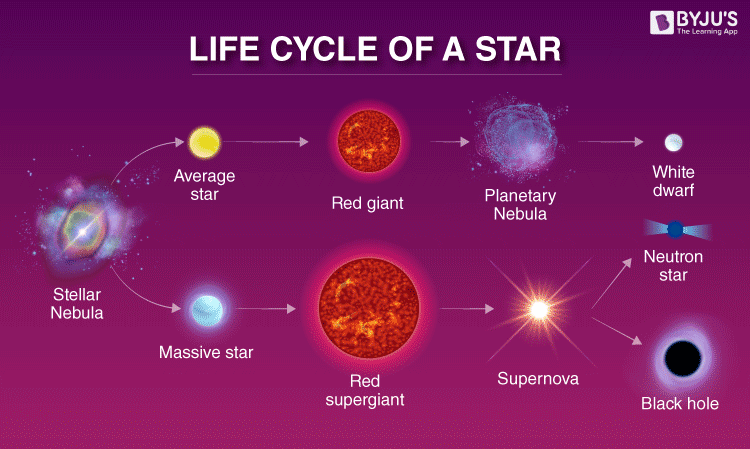
Seven Main Stages of a Star
Stars come in a variety of masses and the mass determines how radiantly the star will shine and how it dies. Massive stars transform into supernovae, neutron stars and black holes while average stars like the sun, end life as a white dwarf surrounded by a disappearing planetary nebula. All stars, irrespective of their size, follow the same 7 stage cycle, they start as a gas cloud and end as a star remnant.
1. Giant Gas Cloud
A star originates from a large cloud of gas. The temperature in the cloud is low enough for the synthesis of molecules. The Orion cloud complex in the Orion system is an example of a star in this stage of life.
2. Protostar
When the gas particles in the molecular cloud run into each other, heat energy is produced. This results in the formation of a warm clump of molecules referred to as the Protostar. The creation of Protostars can be seen through infrared vision as the Protostars are warmer than other materials in the molecular cloud. Several Protostars can be formed in one cloud, depending on the size of the molecular cloud.
3. T-Tauri Phase
A T-Tauri star begins when materials stop falling into the Protostar and release tremendous amounts of energy. The mean temperature of the Tauri star isn’t enough to support nuclear fusion at its core. The T-Tauri star lasts for about 100 million years, following which it enters the most extended phase of development – the Main sequence phase.
4. Main Sequence
The main sequence phase is the stage in development where the core temperature reaches the point for the fusion to commence. In this process, the protons of hydrogen are converted into atoms of helium. This reaction is exothermic; it gives off more heat than it requires and so the core of a main-sequence star releases a tremendous amount of energy.
5. Red Giant
A star converts hydrogen atoms into helium over its course of life at its core. Eventually, the hydrogen fuel runs out, and the internal reaction stops. Without the reactions occurring at the core, a star contracts inward through gravity causing it to expand. As it expands, the star first becomes a subgiant star and then a red giant. Red giants have cooler surfaces than the main-sequence star, and because of this, they appear red than yellow.
6. The Fusion of Heavier Elements
Helium molecules fuse at the core, as the star expands. The energy of this reaction prevents the core from collapsing. The core shrinks and begins fusing carbon, once the helium fusion ends. This process repeats until iron appears at the core. The iron fusion reaction absorbs energy, which causes the core to collapse. This implosion transforms massive stars into a supernova while smaller stars like the sun contract into white dwarfs.
7. Supernovae and Planetary Nebulae
Most of the star material is blasted away into space, but the core implodes into a neutron star or a singularity known as the black hole. Less massive stars don’t explode, their cores contract instead into a tiny, hot star known as the white dwarf while the outer material drifts away. Stars tinier than the sun, don’t have enough mass to burn with anything but a red glow during their main sequence. These red dwarves are difficult to spot. But, these may be the most common stars that can burn for trillions of years.
The above were the seven main stages of the life cycle of a star. Whether big or small, young or old, stars are one of the most beautiful and lyrical objects in all of creation. Next time you look up at the stars, remember, this is how they were created and how they will die.
Did you know that some of the stars we see in the sky may already be dead! Their light travels millions and millions of kilometres, and by the time it reaches us, the star would have died. So the distance between our planet and the stars further away is unimaginable, but measurable still. Watch and learn how these distances can be measured and the secrets hiding among the stars.

To learn more Physics concepts with the help of interactive video lessons, download BYJU’S – The Learning App.
Frequently Asked Questions – FAQs
Choose yes or no: do stars die, what are the different stages of life cycle of stars.
Different stages of life cycle of stars are:
- Giant Gas Cloud
- T-Tauri Phase
- Main Sequence
- The Fusion of Heavier Elements
- Supernovae and Planetary Nebulae
State true or false: All stars start as a gas cloud and end as a star remnant.
In which stage, star converts hydrogen atoms into helium at its core, which reaction takes place inside the star.
Nuclear fusion reaction takes place inside the star.

Put your understanding of this concept to test by answering a few MCQs. Click ‘Start Quiz’ to begin!
Select the correct answer and click on the “Finish” button Check your score and answers at the end of the quiz
Visit BYJU’S for all Physics related queries and study materials
Your result is as below
Request OTP on Voice Call
Leave a Comment Cancel reply
Your Mobile number and Email id will not be published. Required fields are marked *
Post My Comment
This knowledge is vey helpful
Thanks for This Sir
- Share Share
Register with BYJU'S & Download Free PDFs
Register with byju's & watch live videos.

The Life and Death of Stars
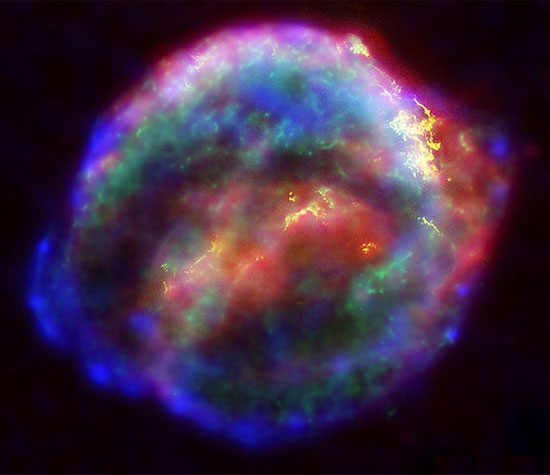
Keplers Supernova (Source: NASA/ESA/JHU/R.Sankrit & W.Blair [Public domain], Wikimedia Commons)
How does this align with my curriculum?
Share on: facebook x/twitter linkedin pinterest.
The life and death of stars form the chemical elements that make up Earth, making stars critical to life as we know it.
Look up at the stars. They may seem like permanent fixtures in the night sky, but did you know that stars eventually die? The life and death of stars form the ingredients that make up Earth, making stars critical to life as we know it.
The early universe contained nothing but the chemical elements hydrogen, helium, and tiny amounts of lithium and beryllium. During their life cycles, stars create elements with low atomic masses. These are the first 26 elements in the periodic table up to and including iron. When most stars die, these light elements spread across the universe, including to planets like Earth.
How are stars born?
Early in the history of the universe, before stars and planets existed, giant clouds of hydrogen and helium began to form. Slowly, these clouds collected enough mass for their own gravity to form. This created extremely dense balls of gas. In other words, they formed stars.
When a new star is formed, its core is exposed to very strong gravitational forces . This force is so great that the star is in danger of collapsing in on itself. Luckily, nuclear fusion provides the energy the star needs to push back against the collapsing core. Nuclear fusion is a process where the nuclei of two or more elements combine to produce nuclei of heavier elements. Nuclear fusion also releases energy.
In the core of a newly formed star, hydrogen nuclei begin to fuse into helium . The inward pull of gravity and the outward push of nuclear fusion eventually balance out. For a time, hydrogen fusion prevents the collapse of the star.
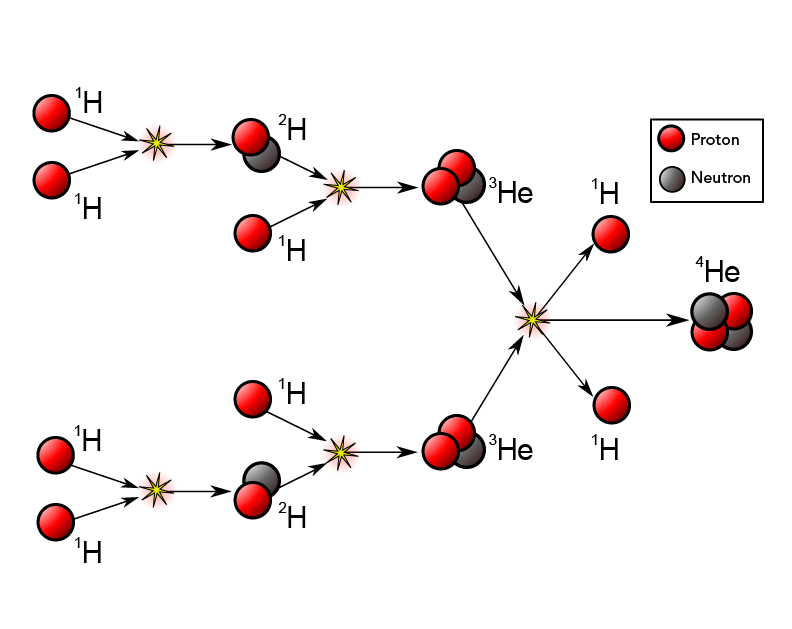
Did you know? The closest star to Earth, the Sun, is fusing hydrogen atoms into helium as you read this!
When the young star runs out of hydrogen, its core will once again begin to collapse. The extreme forces on the core causes it to heat up. Soon, the core is hot enough that it can begin to fuse helium into carbon and oxygen. Once again, nuclear fusion pushes back against gravity to prevent the star from collapsing. One by one, the star fuses each new element. This successively produces elements with low atomic masses like carbon, oxygen, and neon. Not only does nuclear fusion keep stars from collapsing, it enabled the first stars in the universe to create new elements that had never existed before! Depending on their size, stars can create elements through fusion, up to iron, which has an atomic number of 26.
But there are 118 elements in the periodic table. So, where do all the elements with an atomic number higher than iron come from? From the death of stars.
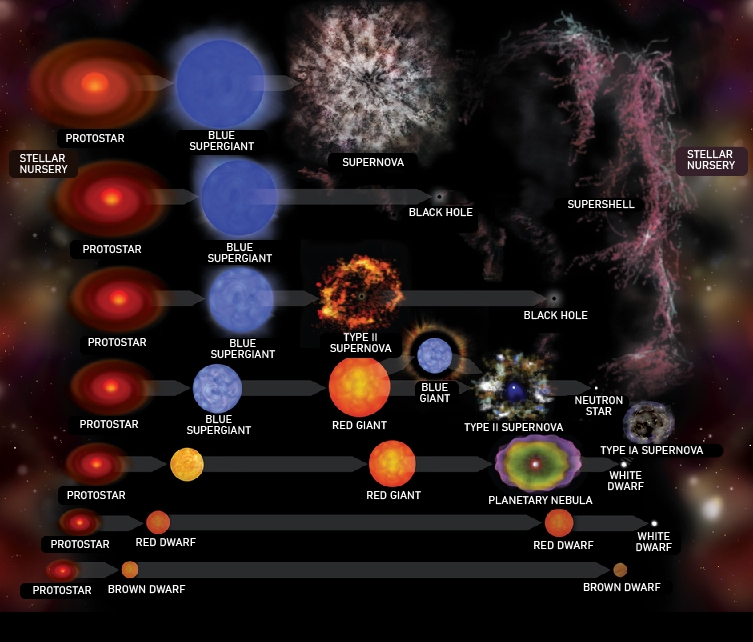
How do stars die?
Even though stars are not living things, they have “life cycles” and at some point they are said to “die.” How a star lives and dies depends on how large it is.
The smallest stars, brown dwarf stars , are too large to be considered planets, but too small to be considered stars. They are unable to sustain the fusion of hydrogen because of their low mass, and are often called "failed stars." The small, slow-burning red dwarf stars have very long lives. Their lives last between one and ten trillion years! Scientists believe that when red dwarf stars eventually collapse, they will become white dwarf stars . These are very dense stars that no longer burn fuel. Scientists also believe that eventually, the white dwarf stars in the universe will cool off and become black dwarf stars .
Did you know? The color of a star is defined by its temperature. T he coolest stars appear red, while the hottest stars appear blue .
When mid-sized stars, like the Sun, run out of hydrogen, their cores will contract and heat up. The outer layers of gas will expand and the stars will become red giant stars . Eventually when the core of a red giant star cools, the remaining gas will float into space, forming a planetary nebula . Each planetary nebula has a white dwarf star at its core.
Did you know? When the Sun becomes a red giant, it will grow so huge that it will swallow Mercury, Venus and possibly Earth before becoming a planetary nebula.
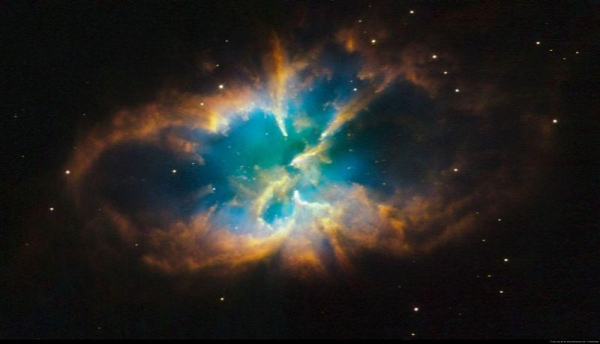
The very largest stars first become blue supergiant stars before dying in a dramatic fashion. In fact, they create the biggest explosions in the universe when they collapse. We call these explosions supernovas .
Did you know? A supernova is so bright that it can outshine an entire galaxy of a hundred billion stars!
The initial explosion of a supernova has so much energy that it can split atoms apart at the core, sending protons and neutrons flying into the universe. In the moments following the explosion, these particles crash into each other with enough energy to fuse back together. Light elements continue colliding with protons and neutrons in this way, constantly growing larger and larger. This process, which is similar to nuclear fusion, is called nucleosynthesis . The nucleosynthesis that occurs during the explosion of a supernova produces elements with a higher atomic number than iron, which cannot be created by nuclear fusion. When the first stars died out this way, brand new elements, including gold, were formed. Eventually, those elements ended up here on Earth.
After a supernova explodes, the core that remains becomes a neutron star . This is an extremely small and dense type of star. For the largest stars of all, the remaining core is so massive and has such a strong gravitational pull that not even light can escape. This is called a stellar black hole .
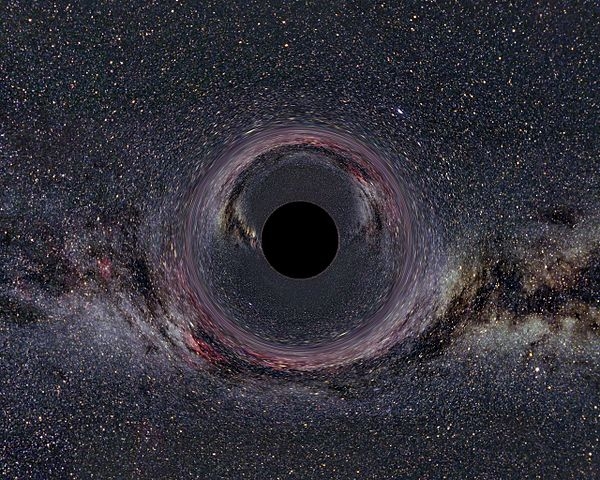
No matter how a star dies, its life cycle can transform the universe. Without stars, the universe would contain nothing but clouds of hydrogen and helium. It is the life and death of stars that are responsible for the elements that make up everything you see on Earth!
Did you know? Models of supernova explosions predict the creation of elements that aren’t even found on Earth! Scientists call them exotic nuclei .
Starting Points
Connecting and relating.
- How is the life cycle of a star similar to the life cycle of a living thing? How is it different?
- Have you ever heard the saying, “We are made of star-stuff. There are pieces of stars within us all,” by the famous astrophysicist and science communicator Carl Sagan ? Before reading this article, what did you think this quote meant? Did your understanding of this quote alter after you read the article? If so, how?
Relating Science and Technology to Society and the Environment
- The life cycle of a star takes place over billions of years. How have astrophysicists been able to understand how stars change over such huge expanses of time?
Exploring Concepts
- Under what conditions do stars produce different chemical elements?
- How is nuclear fusion different from nucleosynthesis?
- What is a supernova? How does a supernova result in the formation of elements?
- How does the size of star impact on its lifecycle?
Nature of Science/Nature of Technology
- Why is it important to understand chemistry and physics when learning about the life cycle of stars?
- What is astrophysics? What is the difference between astrophysics and astronomy?
Media Literacy
- Do you know any songs or musical compositions about stars? Why do you think the stars have been inspiration for music?
Teaching Suggestions
- This article supports teaching and learning in chemistry and the topic of space. The concepts of nuclear fusion and nucleosynthesis are introduced in the context of the life cycle of stars and the formation of the elements.
- Before reading the article, teachers could ask students questions from the Connecting & Relating section to get them thinking about life cycles in general and to access their prior knowledge about stars.
- Prior to reading the article, teachers may also wish to provide students with a Vocabulary Preview to introduce the new terms that will be encountered in the reading. Download Vocabulary Preview learning strategy reproducibles in [ Google doc ] and [ PDF ] formats.
- To consolidate learning, Students could create their own infographic depicting the life cycle of a certain type of star.
The last light before eternal darkness: Black dwarfs & white dwarfs (2017)
This video (6:28 min.) from Kurzegagst contains useful information on black dwarfs, white dwarfs and other types of stars.
Making new elements (2013)
An article explaining how scientists make superheavy elements.
Life Cycle of A Star
Article from the National Schools Observatory explains the processes in simple terms with hyperlinks to all the related keywords.
The life cycle of stars (2012)
A video from the Institute of Physics that explains how we believe stars are born, live, and die.
Cain, F. (2015, April 9). How quickly does a supernova happen? Universe Today.
Freudenrich, C. (2016, November 17). How stars work . HowStuffWorks.
ITER Organization. (2016, November 24). Fusion .
Redd, N. T. (2018, February 24). Neutron stars: Definition & facts . Space.com.
Science Learning Hub. (2009, October 22). How elements are formed.
Smith, H. R. (2018, August 21). What Is a black hole? NASA.
Voght, Y. (2012, May 8). New insight into atomic nuclei may explain how supernovas formed elements crucial to humankind . ScienceDaily.
Related Topics

IMAGES
VIDEO
COMMENTS
The paper has noted that all stars are formed from a nebula cloud. It has revealed that the life expectancy of stars can vary from a million to many billions of years depending on their mass. A star begins to die when it runs out of hydrogen and the fusion reaction can no longer occur.
Every star has its own life cycle, ranging from a few million to trillions of years, and its properties change as it ages. Birth. Stars form in large clouds of gas and dust called molecular clouds. Molecular clouds range from 1,000 to 10 million times the mass of the Sun and can span as much as hundreds of light-years. Molecular clouds are cold ...
250 Words Essay on Life Cycle Of Stars Birth of Stars. Stars begin life as clouds of dust and gas. The cloud, called a nebula, starts to shrink under its own gravity. As it contracts, the center gets warmer and denser. When the core gets hot enough, nuclear reactions start. This is when a star is born, shining because it turns hydrogen into helium.
At the first stage of their lives, stars are formed by the gravitational collapse of giant clouds of dust and gas called Nebulae. This stage is the start of their life cycle. 2. Protostar. A protostar is the result of the gravitational collapse of a nebula. It is the formative phase of a star.
Life Cycle of a Star. All stars form in nebulae, which are huge clouds of gas and dust. Though they shine for many thousands, and even millions of years, stars do not last forever. The changes that occur in a star over time and the final stage of its life depend on a star's size . Nuclear reactions at the centre (or core) of a star provides ...
Star - Formation, Evolution, Lifecycle: Throughout the Milky Way Galaxy (and even near the Sun itself), astronomers have discovered stars that are well evolved or even approaching extinction, or both, as well as occasional stars that must be very young or still in the process of formation. Evolutionary effects on these stars are not negligible, even for a middle-aged star such as the Sun.
Webb's amazing imaging and spectroscopy capabilities is allowing us to study stars as they are forming in their dusty cocoons. Additionally, it is able to image disks of heated material around these young stars, which can indicate the beginnings of planetary systems, and study organic molecules that are important for life to develop.
Old age: red giant This simulation shows how, after depleting the hydrogen in its core, an intermediate-mass star contracts and heats up until it sets off the fusion of helium into heavier elements. Helium fusion provides a second stable phase, covering the last 10 percent of the star's life. The increase in energy production puffs out the star's atmosphere, resulting in a highly luminous ...
A star is born. The life cycle of a star spans billions of years. As a general rule, the more massive the star, the shorter its life span. Birth takes place inside hydrogen-based dust clouds ...
A mature star may shine steadily for millions or even billions of years. The single biggest factor in the length of its life is the star's mass. Large, massive stars, such as red giants and supergiants, tend to burn out their hydrogen fuel quickly. Smaller stars are more fuel-efficient and last the longest. But no matter the size, there is ...
A star's life cycle is determined by its mass. The larger its mass, the shorter its life cycle. A star's mass is determined by the amount of matter that is available in its nebula, the giant cloud of gas and dust from which it was born. Over time, the hydrogen gas in the nebula is pulled together by gravity and it begins to spin.
Most of the other elements have been born from the life cycle, or evolution, of stars where lighter elements such as hydrogen and helium combine into heavier elements like oxygen and carbon through fusion. The heaviest elements are formed when stars go supernova, creating enough energy to fuse molecules together into carbon, oxygen, and even ...
View on YouTube. Launchpad: Life Cycle of a Star. Watch on. Each of us is made from star stuff. But how are stars formed? Take a closer look at the life cycles of stars and learn where stars come from, how they’ve changed, and what happens to stars when their lives come to an end. Find out about your connection to the cosmos.
Massive stars transform into supernovae, neutron stars and black holes while average stars like the sun, end life as a white dwarf surrounded by a disappearing planetary nebula. All stars, irrespective of their size, follow the same 7 stage cycle, they start as a gas cloud and end as a star remnant. 1. Giant Gas Cloud.
In this well-illustrated text, Kenneth R. Lang explains the life cycle of stars, from the dense molecular clouds that are stellar nurseries to the enigmatic nebulae that some stars leave ... 150 figures, including color plates, The Life and Death of Stars is a modern and up-to-date account of stars written for a broad audience, from armchair ...
The life and death of stars form the ingredients that make up Earth, making stars critical to life as we know it. The early universe contained nothing but the chemical elements hydrogen, helium, and tiny amounts of lithium and beryllium. During their life cycles, stars create elements with low atomic masses. These are the first 26 elements in ...
The Life Cycle of a Star Essay. Our Sun is a perfect example of a star, and there is an incredible amount of stars in the Universe. It is a star among hundreds of billions of stars within our Milky Way Galaxy, and our galaxy is one of billions of galaxies in the universe. Stars live for a very long time; millions, billions, or tens of billions ...
The Life Cycles of Stars Dr. Jim Lochner, NASA/GSFC May 15, 2001 . ... determine the stages of a star's life. New Stars are not quiet ! Expulsion of gas from a young binary star system . All Types of Stars . Annie J Cannon (1863-1941) Oh Big And Ferocious Gorilla, Kill My Roommate Next
How do stars form, evolve and die? Find out in this GCSE Bitesize Physics guide that covers the life cycle of stars, main sequence stars and supernovae. Learn the facts and test your knowledge ...
A star originates in a nebula—a large, cold cloud of gas and dust. According to NASA, "Over time, the hydrogen gas in the nebula is pulled together by gravity and it begins to spin" ("The Life Cycles of Stars: How Supernovae Are Formed"). The stages continue based on temperature as the nebula warms up.
The life cycle of a star larger than the Sun starts in the same way as a solar mass star. 1. Nebula. All stars form from a giant cloud of hydrogen gas and dust called a nebula. 2. Protostar. The force of gravity within a nebula pulls the particles closer together until it forms a hot ball of gas, known as a protostar.
The Life Cycle of Solar Mass Stars. 1. Nebula. All stars form from a giant cloud of hydrogen gas and dust called a nebula. 2. Protostar. The force of gravity within a nebula pulls the particles closer together until it forms a hot ball of gas, known as a protostar. As the particles are pulled closer together the density of the protostar will ...
S. Cabral. Life cycle of Stars. Our Sun is a perfect example of a star, and there is an incredible amount of stars in the Universe. Stars live for a very long time; millions, billions, or tens of billions of years so we can never really observe the life of a star; its birth, life, and death. In determining the life cycle of a star, astronomers ...